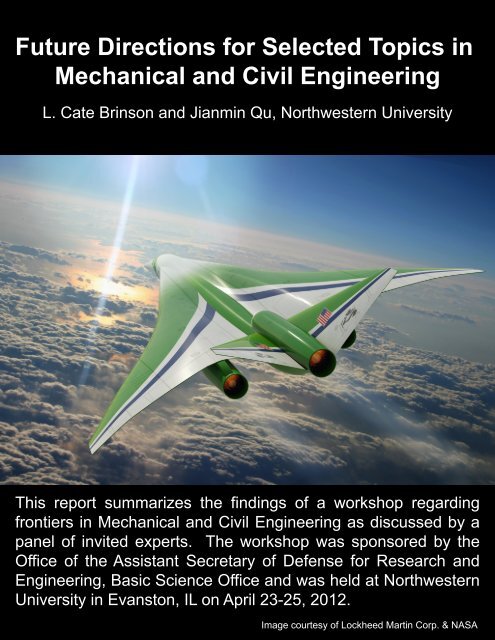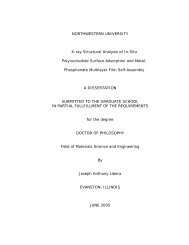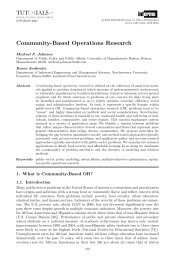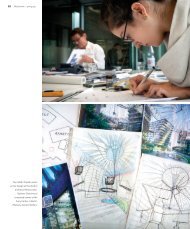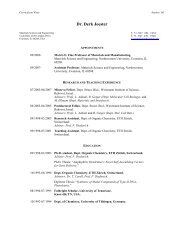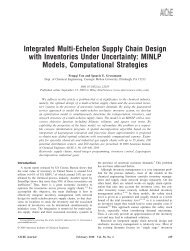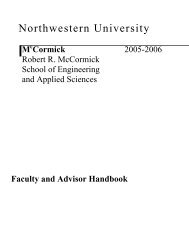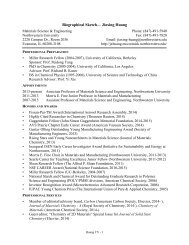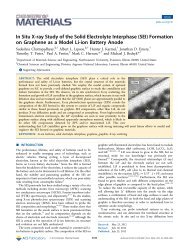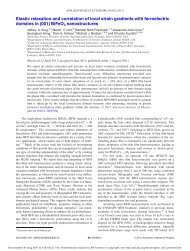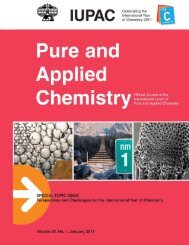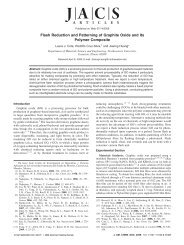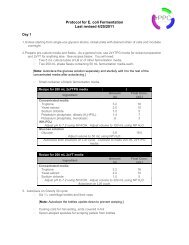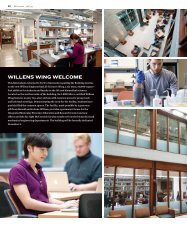Future Directions for Selected Topics in Mechanical and Civil ...
Future Directions for Selected Topics in Mechanical and Civil ...
Future Directions for Selected Topics in Mechanical and Civil ...
Create successful ePaper yourself
Turn your PDF publications into a flip-book with our unique Google optimized e-Paper software.
<strong>Future</strong> <strong>Directions</strong> <strong>for</strong> <strong>Selected</strong> <strong>Topics</strong> <strong>in</strong><br />
<strong>Mechanical</strong> <strong>and</strong> <strong>Civil</strong> Eng<strong>in</strong>eer<strong>in</strong>g<br />
L. Cate Br<strong>in</strong>son <strong>and</strong> Jianm<strong>in</strong> Qu, Northwestern University<br />
This report summarizes the f<strong>in</strong>d<strong>in</strong>gs of a workshop regard<strong>in</strong>g<br />
frontiers <strong>in</strong> <strong>Mechanical</strong> <strong>and</strong> <strong>Civil</strong> Eng<strong>in</strong>eer<strong>in</strong>g as discussed by a<br />
panel of <strong>in</strong>vited experts. The workshop was sponsored by the<br />
Office of the Assistant Secretary of Defense <strong>for</strong> Research <strong>and</strong><br />
Eng<strong>in</strong>eer<strong>in</strong>g, Basic Science Office <strong>and</strong> was held at Northwestern<br />
University <strong>in</strong> Evanston, IL on April 23-25, 2012.<br />
Image courtesy of Lockheed Mart<strong>in</strong> Corp. & NASA
1!<br />
FUTURE DIRECTIONS FOR SELECTED TOPICS IN<br />
MECHANICAL AND CIVIL ENGINEERING<br />
L Cate Br<strong>in</strong>son <strong>and</strong> Jianm<strong>in</strong> Qu<br />
Northwestern University<br />
Sponsored by the Office of the Assistant Secretary of Defense <strong>for</strong> Research <strong>and</strong><br />
Eng<strong>in</strong>eer<strong>in</strong>g, Basic Science Office<br />
Northwestern University<br />
April 23-25, 2012<br />
(All images available under the public doma<strong>in</strong> or reproduced with proper permissions)<br />
Table of Contents<br />
1.! Executive Summary 3!<br />
2.! Background <strong>and</strong> Introduction 6!<br />
3.! Application doma<strong>in</strong>s with high impact <strong>and</strong> emerg<strong>in</strong>g challenges 8!<br />
3.1.! Energy 9!<br />
3.2.! Water 11!<br />
3.3.! Eng<strong>in</strong>eer<strong>in</strong>g <strong>for</strong> Human Health <strong>and</strong> Safety 12!<br />
3.4.! Infrastructure 14!<br />
3.5.! Manufactur<strong>in</strong>g 16!<br />
4.! Technological developments required to meet emerg<strong>in</strong>g challenges 17!<br />
4.1.! Ubiquitous sensor network 17!<br />
4.1.1.! Development of smart sensors 17!<br />
4.1.2.! Rapid deployment of mobile sensor network 18!<br />
4.2.! Cloud comput<strong>in</strong>g <strong>for</strong> storage, shar<strong>in</strong>g <strong>and</strong> process<strong>in</strong>g 19!<br />
4.2.1.! Model<strong>in</strong>g, simulation, <strong>and</strong> process<strong>in</strong>g of sensor data 19!<br />
4.2.2.! Cloud design <strong>and</strong> manufactur<strong>in</strong>g 20!<br />
4.2.3.! Materials genome development <strong>for</strong> hybrid system design (bottom-up) 21!<br />
4.3.! Systems level approaches 23!<br />
4.3.1.! Tools <strong>for</strong> systems-level underst<strong>and</strong><strong>in</strong>g <strong>and</strong> optimization (top-down) 23!
2!<br />
4.3.2.! Interdependent systems approach <strong>for</strong> <strong>in</strong>frastructure risk management 24!<br />
4.4.! Multi-functional <strong>in</strong>frastructure materials 24!<br />
4.5.! Integration of experimental <strong>and</strong> model<strong>in</strong>g tools <strong>for</strong> coupled multi-scale <strong>and</strong> multiphysics<br />
systems 26!<br />
4.5.1.! Integration of Advanced Methods of Mechanics, Probability, <strong>and</strong> Experiments 27!<br />
4.5.2.! Tools <strong>for</strong> meso-scale technology 27!<br />
4.5.3.! Tools <strong>for</strong> address<strong>in</strong>g uncerta<strong>in</strong>ty (UQ <strong>and</strong> VV) 28!<br />
4.5.4.! Integration between social/behavioral <strong>and</strong> physics-based models 28!<br />
4.5.5.! Far from equilibrium thermal <strong>and</strong> material systems 29!<br />
4.6.! Robot mobility <strong>and</strong> situation awareness 30!<br />
4.7.! Adaptive <strong>and</strong> scalable manufactur<strong>in</strong>g processes 31!<br />
4.7.1.! Interface eng<strong>in</strong>eer<strong>in</strong>g 33!<br />
4.7.2.! Three-dimensional characterization techniques 34!<br />
4.7.3.! Three-dimensional fabrication methods – Additive Manufactur<strong>in</strong>g 35!<br />
4.7.4.! Parts with <strong>in</strong>tegrated multi-functions <strong>and</strong> self-description 35!<br />
5.! International Context 36!<br />
5.1.! Energy 36!<br />
5.2.! Water 38!<br />
5.3.! Eng<strong>in</strong>eer<strong>in</strong>g <strong>for</strong> Human Health <strong>and</strong> Safety 38!<br />
5.3.1.! Bio-marker sensor development 38!<br />
5.3.2.! Pharmaceutical <strong>in</strong>dustries 39!<br />
5.4.! Infrastructure 40!<br />
5.5.! Manufactur<strong>in</strong>g 41!<br />
6.! Conclud<strong>in</strong>g Remarks 42!<br />
!
3!<br />
1. Executive Summary<br />
The Workshop on <strong>Future</strong> <strong>Directions</strong> <strong>in</strong> <strong>Mechanical</strong> <strong>and</strong> <strong>Civil</strong> Eng<strong>in</strong>eer<strong>in</strong>g was<br />
sponsored by the Office of the Assistant Secretary of Defense <strong>for</strong> Research <strong>and</strong><br />
Eng<strong>in</strong>eer<strong>in</strong>g (ASD(R&E)) <strong>and</strong> was held at Northwestern University on April 23-25, 2012.<br />
The participants <strong>in</strong> the workshop <strong>in</strong>cluded 34 <strong>in</strong>vited scientists/eng<strong>in</strong>eers <strong>and</strong> 3<br />
government observers, as listed <strong>in</strong> Appendix I.<br />
The ma<strong>in</strong> objectives of the workshop were to identify specialized applicationdoma<strong>in</strong>-based<br />
areas <strong>in</strong> the fields of mechanical <strong>and</strong> civil eng<strong>in</strong>eer<strong>in</strong>g that hold high<br />
promise <strong>for</strong> long-term (10+ years) technological breakthroughs <strong>and</strong> to identify the<br />
technological needs that will be required to meet these emerg<strong>in</strong>g challenges. These<br />
considerations were framed with<strong>in</strong> an <strong>in</strong>ternational context <strong>in</strong> order to provide<br />
recommendations to the ASD(R&E) regard<strong>in</strong>g key areas of high potential growth that<br />
will be critical <strong>for</strong> ensur<strong>in</strong>g that the United States cont<strong>in</strong>ues to be a world leader with<strong>in</strong><br />
the realm of mechanical <strong>and</strong> civil eng<strong>in</strong>eer<strong>in</strong>g.<br />
Over the course of the workshop, five application doma<strong>in</strong>s were p<strong>in</strong>po<strong>in</strong>ted as<br />
hold<strong>in</strong>g particularly high potential <strong>for</strong> long-term growth <strong>in</strong> the fields of mechanical <strong>and</strong><br />
civil eng<strong>in</strong>eer<strong>in</strong>g <strong>in</strong> light of recent <strong>and</strong> expected technological breakthroughs. The<br />
follow<strong>in</strong>g list summarizes some of the key emerg<strong>in</strong>g challenges <strong>in</strong> these application<br />
doma<strong>in</strong>s (see Section 3 <strong>for</strong> more detail):<br />
1) Energy<br />
• Energy conversion/storage devices <strong>and</strong> <strong>in</strong>frastructure<br />
• Energy efficiency of build<strong>in</strong>gs<br />
• Efficiency of power generation<br />
• Enhanced multi-physics model<strong>in</strong>g <strong>and</strong> material design <strong>for</strong> enhanced<br />
energy recovery<br />
• Sens<strong>in</strong>g systems <strong>in</strong> energy facilities<br />
2) Water<br />
• Separation processes <strong>for</strong> obta<strong>in</strong><strong>in</strong>g potable water
4!<br />
• Monitor<strong>in</strong>g/control systems (leak detection, water quality assessment,<br />
security, etc.) <strong>and</strong> structural health monitor<strong>in</strong>g<br />
• Water-energy nexus<br />
3) Eng<strong>in</strong>eer<strong>in</strong>g <strong>for</strong> Human Health <strong>and</strong> Safety<br />
• Personalized, po<strong>in</strong>t-of-care disease diagnosis/treatment<br />
• Lightweight protective materials<br />
• Emergency response to disasters (man-made or natural)<br />
4) Infrastructure<br />
• High-level risk management<br />
• Infrastructure plann<strong>in</strong>g <strong>for</strong> extreme events<br />
• Structural health monitor<strong>in</strong>g via ubiquitous sensor network<br />
• Advanced model<strong>in</strong>g, simulation, <strong>and</strong> process<strong>in</strong>g methods <strong>in</strong>corporat<strong>in</strong>g<br />
uncerta<strong>in</strong>ty analysis<br />
• Multifunctional <strong>in</strong>frastructure materials<br />
5) Manufactur<strong>in</strong>g<br />
• Development of new scalable/adaptive manufactur<strong>in</strong>g methods<br />
• Multidimensional 3D manufactur<strong>in</strong>g techniques with real-time<br />
feedback/control<br />
• Cloud process<strong>in</strong>g to <strong>in</strong>tegrate model<strong>in</strong>g tools <strong>in</strong>corporat<strong>in</strong>g human<br />
behavior with enormous amounts of generated data<br />
• Distributed manufactur<strong>in</strong>g<br />
Meet<strong>in</strong>g the challenges above will require the ref<strong>in</strong>ement or development of a<br />
number of cross-cutt<strong>in</strong>g technologies, as discussed <strong>in</strong> detail <strong>in</strong> Section 4 of this report:<br />
1) Ubiquitous sensor network<br />
• Development of smart sensors<br />
• Rapid deployment of mobile sensor network<br />
2) Cloud comput<strong>in</strong>g <strong>for</strong> storage/shar<strong>in</strong>g<br />
• Cloud design <strong>and</strong> manufactur<strong>in</strong>g<br />
• Model<strong>in</strong>g, simulation, <strong>and</strong> process<strong>in</strong>g of sensor data<br />
• Materials genome development
5!<br />
3) Systems-level approaches<br />
• Tools <strong>for</strong> systems-level underst<strong>and</strong><strong>in</strong>g/optimization<br />
• Interdependent <strong>in</strong>frastructure risk management<br />
4) Multi-functional <strong>in</strong>frastructure materials<br />
• Self-heal<strong>in</strong>g<br />
• Sens<strong>in</strong>g/actuat<strong>in</strong>g<br />
• Recycl<strong>in</strong>g/susta<strong>in</strong>ability<br />
5) Integration of experimental <strong>and</strong> model<strong>in</strong>g tools <strong>for</strong> multi-scale, multi-physics<br />
systems<br />
• Integration of advanced analytical models <strong>and</strong> experimental/ sens<strong>in</strong>g<br />
techniques with<strong>in</strong> a probabilistic framework, <strong>in</strong>clud<strong>in</strong>g uncerta<strong>in</strong>ty<br />
• Tools <strong>for</strong> meso-scale technology<br />
• Integration between social/behavioral <strong>and</strong> physics-based models<br />
• Far from equilibrium thermal <strong>and</strong> material systems<br />
• Underst<strong>and</strong><strong>in</strong>g/controll<strong>in</strong>g evolution of material behavior<br />
6) Robot mobility <strong>and</strong> situation awareness<br />
• locomotion modes<br />
• map-build<strong>in</strong>g <strong>and</strong> localization<br />
• teleoperation<br />
7) Adaptive <strong>and</strong> scalable manufactur<strong>in</strong>g processes<br />
• Interface eng<strong>in</strong>eer<strong>in</strong>g<br />
• 3D characterization techniques<br />
• 3D fabrication methods<br />
• Part with <strong>in</strong>tegrated multi-functions <strong>and</strong> self-description<br />
The challenges with<strong>in</strong> the five application doma<strong>in</strong>s <strong>and</strong> technology development<br />
described <strong>in</strong> the lists above were all framed with<strong>in</strong> an <strong>in</strong>ternational context <strong>in</strong> which the<br />
United States was viewed as a leader <strong>in</strong> certa<strong>in</strong> areas with<strong>in</strong> the fields of mechanical<br />
<strong>and</strong> civil eng<strong>in</strong>eer<strong>in</strong>g, whereas U.S. leadership <strong>in</strong> other areas was determ<strong>in</strong>ed to be<br />
unclear or <strong>in</strong> jeopardy. Section 5 of this report provides a detailed description of the<br />
<strong>in</strong>ternational context <strong>for</strong> each of the five application doma<strong>in</strong>s listed above.
6!<br />
The rema<strong>in</strong>der of this report summarizes the proceed<strong>in</strong>gs of the workshop <strong>in</strong><br />
several ma<strong>in</strong> sections. First, Section 2 provides a brief overview of the logistics of the<br />
workshop. Section 3 goes on to describe the five major application doma<strong>in</strong>s determ<strong>in</strong>ed<br />
to hold particularly significant long-term challenges with<strong>in</strong> the fields of mechanical <strong>and</strong><br />
civil eng<strong>in</strong>eer<strong>in</strong>g. Section 4 addresses the cross-cutt<strong>in</strong>g technological advances that will<br />
be required to meet the challenges described <strong>for</strong> the application doma<strong>in</strong>s discussed <strong>in</strong><br />
Section 3. F<strong>in</strong>ally, Section 5 describes the <strong>in</strong>ternational context <strong>for</strong> both the current<br />
state <strong>and</strong> future growth of mechanical <strong>and</strong> civil eng<strong>in</strong>eer<strong>in</strong>g <strong>in</strong> the United States, <strong>and</strong><br />
Section 6 offers some conclud<strong>in</strong>g remarks.<br />
2. Background <strong>and</strong> Introduction<br />
The fields of mechanical <strong>and</strong> civil eng<strong>in</strong>eer<strong>in</strong>g span a wide range of discipl<strong>in</strong>es,<br />
as <strong>in</strong>dicated by the Venn diagram <strong>in</strong> Figure 1. It is worth not<strong>in</strong>g that this is only one<br />
possible breakdown of these larger eng<strong>in</strong>eer<strong>in</strong>g fields <strong>and</strong> that the discipl<strong>in</strong>es noted are<br />
not exhaustive. In order to explore the full scope of these eng<strong>in</strong>eer<strong>in</strong>g fields with<strong>in</strong> the<br />
workshop, scientists <strong>and</strong> eng<strong>in</strong>eers with expertise <strong>in</strong> each of the subdiscipl<strong>in</strong>es noted <strong>in</strong><br />
Figure 1 were <strong>in</strong>vited to discuss the current state of mechanical <strong>and</strong> civil eng<strong>in</strong>eer<strong>in</strong>g<br />
<strong>and</strong> the emerg<strong>in</strong>g areas with<strong>in</strong> these fields with high potential <strong>for</strong> growth.<br />
Figure 1: Venn diagram <strong>in</strong>dicat<strong>in</strong>g the breakdown of discipl<strong>in</strong>es with<strong>in</strong> mechanical <strong>and</strong><br />
civil eng<strong>in</strong>eer<strong>in</strong>g chosen <strong>for</strong> this workshop
7!<br />
The workshop began with a brief (5-m<strong>in</strong>ute) presentation by each <strong>in</strong>vited<br />
participant outl<strong>in</strong><strong>in</strong>g his or her work along with a recent breakthrough <strong>and</strong> emerg<strong>in</strong>g<br />
technological challenges with<strong>in</strong> his or her area of expertise, with common themes<br />
summarized <strong>in</strong> Table 1. These ideas were used as a start<strong>in</strong>g po<strong>in</strong>t <strong>for</strong> further<br />
discussions regard<strong>in</strong>g challenges <strong>in</strong> broad application doma<strong>in</strong>s <strong>and</strong> the discipl<strong>in</strong>e-based<br />
technological advances required to meet those challenges.<br />
Table 1: List of discipl<strong>in</strong>e-based recent breakthroughs <strong>and</strong> emerg<strong>in</strong>g technological<br />
needs outl<strong>in</strong>ed by workshop participants<br />
Discipl<strong>in</strong>ary Doma<strong>in</strong><br />
Structural Health Monitor<strong>in</strong>g<br />
Design<br />
Manufactur<strong>in</strong>g<br />
Micro-Nano Eng<strong>in</strong>eer<strong>in</strong>g<br />
Systems<br />
Heat/Fluid Transfer<br />
Mechanics of Materials<br />
Geotechnology<br />
Transportation<br />
Structures<br />
Recent Breakthrough<br />
Damage-sens<strong>in</strong>g materials<br />
Structural topology <strong>and</strong><br />
material design<br />
Globalized manufactur<strong>in</strong>g<br />
Multi-scale<br />
fabrication/characterization<br />
Nanotechnology-based<br />
sensors<br />
Microfluidics<br />
Quantitative Nanoscale <strong>in</strong>situ<br />
<strong>and</strong> 3D Characterization<br />
Multi-phase model<strong>in</strong>g<br />
methods; Self-learn<strong>in</strong>g<br />
simulations; Subsurface<br />
imag<strong>in</strong>g<br />
Intelligent transportation<br />
systems<br />
Composite materials with<br />
<strong>in</strong>creased functionality<br />
Emerg<strong>in</strong>g Technological<br />
Challenge<br />
Susta<strong>in</strong>able, self-heal<strong>in</strong>g,<br />
"smart" materials<br />
Design via cloud process<strong>in</strong>g<br />
Adaptive/scalable processes;<br />
3D manufactur<strong>in</strong>g<br />
Materials genomics; <strong>in</strong>terface<br />
eng<strong>in</strong>eer<strong>in</strong>g<br />
Ubiquitous sensor network<br />
<strong>for</strong> real-time systems<br />
assessment<br />
High-power work via waste<br />
heat recovery; control of far<br />
from equilibrium systems<br />
Integrated multi-scale<br />
model<strong>in</strong>g techniques<br />
Multi-physics model<strong>in</strong>g;<br />
Adaptive <strong>in</strong>tegrated designconstruction-monitor<strong>in</strong>g<br />
Real-time<br />
control/management of<br />
transportation systems<br />
Multi-functional, susta<strong>in</strong>able<br />
Infrastructure materials
8!<br />
Figure 2 illustrates the flow of the workshop, which proceeded by a comb<strong>in</strong>ation<br />
of round-table group discussions <strong>and</strong> breakout sessions <strong>in</strong> which the participants were<br />
divided <strong>in</strong>to four discipl<strong>in</strong>e-based or application-doma<strong>in</strong>-based groups. A detailed<br />
description of the organization of the workshop is provided <strong>in</strong> Appendix 2.<br />
-$%5C5%#(*&:7+6+$1(."$6,&<br />
%+6275)5$4&7+2+$1&)7+(&<br />
;7+(
9!<br />
4) Infrastructure<br />
5) Manufactur<strong>in</strong>g<br />
These application doma<strong>in</strong>s were each discussed with<strong>in</strong> the context of significant<br />
emerg<strong>in</strong>g technical challenges. The follow<strong>in</strong>g subsections provide an overview of the<br />
<strong>for</strong>eseen challenges <strong>in</strong> each of these doma<strong>in</strong>s, <strong>and</strong> the technological developments that<br />
will be required to meet these challenges are subsequently described <strong>in</strong> Section 4.<br />
Figure 3: Representative images of the five application doma<strong>in</strong>s deemed as the most<br />
significant drivers <strong>for</strong> change: Energy (w<strong>in</strong>d, geothermal, solar, hydroelectric), Water<br />
(desal<strong>in</strong>ation plant), Infrastructure (Chicago “El” cross junction), Eng<strong>in</strong>eer<strong>in</strong>g <strong>for</strong> Human<br />
Health <strong>and</strong> Safety (DNA microarray; IED detonator), <strong>and</strong> Manufactur<strong>in</strong>g (m<strong>in</strong>iature 3Dpr<strong>in</strong>ted<br />
turb<strong>in</strong>e)<br />
3.1. Energy<br />
The energy doma<strong>in</strong> provides many gr<strong>and</strong> challenges <strong>for</strong> the discipl<strong>in</strong>es of<br />
mechanical <strong>and</strong> civil eng<strong>in</strong>eer<strong>in</strong>g. Several areas of key importance (with details to<br />
follow) can be summarized as:<br />
• High-power alternative energy conversion/storage devices
10!<br />
• Increased energy efficiency of build<strong>in</strong>gs<br />
• Interface eng<strong>in</strong>eer<strong>in</strong>g by design <strong>for</strong> efficient power generation<br />
• Enhanced multi-physics (i.e., chemo-thermo-hydro-mechano-electro) model<strong>in</strong>g<br />
• Enhanced sens<strong>in</strong>g network <strong>for</strong> energy <strong>in</strong>frastructure<br />
There is grow<strong>in</strong>g dem<strong>and</strong> <strong>for</strong> energy conversion <strong>and</strong> storage devices such as<br />
batteries <strong>and</strong> fuel cells, which require the design of efficient <strong>and</strong> durable material<br />
systems. Furthermore, as the prevalence of these devices exp<strong>and</strong>s, there will be<br />
significant <strong>in</strong>frastructure needs <strong>for</strong> electric <strong>and</strong> hydrogen vehicles as related to the<br />
sources, storage, <strong>and</strong> transport of fuels. An efficient, flexible grid <strong>in</strong>frastructure based<br />
on <strong>in</strong>termittent renewable power sources will need to be set <strong>in</strong> place, directly relevant to<br />
Department of Defense <strong>in</strong>terest <strong>in</strong> more efficient power systems <strong>in</strong> deployments such as<br />
emergency response. A supply cha<strong>in</strong> challenge regard<strong>in</strong>g the <strong>in</strong>creased pervasiveness<br />
of energy conversion <strong>and</strong> storage devices lies <strong>in</strong> secur<strong>in</strong>g resources <strong>for</strong> the constituent<br />
materials from overseas (e.g. rare earth metals, phosphorous, etc). While government<br />
<strong>in</strong>vestment <strong>in</strong> fuel cells is on the rise <strong>in</strong> countries such as Japan, there was concern<br />
among the workshop participants that government <strong>in</strong>vestment may be decl<strong>in</strong><strong>in</strong>g<br />
domestically.<br />
A second energy-related challenge is the energy efficiency of build<strong>in</strong>gs. Sensor<br />
<strong>and</strong> control systems, along with the further development of multi-functional materials,<br />
will prove <strong>in</strong>valuable <strong>for</strong> mak<strong>in</strong>g optimal use of available energy <strong>and</strong> reduc<strong>in</strong>g the<br />
amount of wasted energy.<br />
Another challenge is the energy efficiency of power generation. Increased<br />
efficiency requires low-friction surfaces via a new age of tribology <strong>for</strong> reduced losses <strong>in</strong><br />
energy, as well as precise nano-scale control over surface functionalization (e.g., superhydrophobicity).<br />
The development of manufactur<strong>in</strong>g techniques towards up-scal<strong>in</strong>g of<br />
this nano-scale control over large surface areas rema<strong>in</strong>s a further challenge.
11!<br />
Enhanced multi-physics models <strong>in</strong>corporat<strong>in</strong>g coupled chemo-thermo-hydromechano-electro<br />
properties provides a challenge to improve control of exist<strong>in</strong>g<br />
hydrocarbon resources <strong>and</strong> new energy sources <strong>for</strong> such concerns as enhanced oil<br />
recovery (EOR), gas shales, <strong>and</strong> enhanced geothermal systems (EGS). The design of<br />
materials with improved high-temperature <strong>and</strong> high-pressure properties, as well as<br />
corrosion <strong>and</strong> abrasion per<strong>for</strong>mance, rema<strong>in</strong> a challenge <strong>for</strong> deep drill<strong>in</strong>g of fuel<br />
resources (<strong>and</strong> other applications <strong>in</strong> the energy <strong>in</strong>dustry) that are currently unatta<strong>in</strong>able<br />
by current technologies.<br />
The role of sens<strong>in</strong>g systems <strong>in</strong> energy facilities rema<strong>in</strong>s a challenge. Systems<br />
that can detect <strong>and</strong> evaluate damage are required to reduce the risk to human life <strong>and</strong><br />
health, <strong>and</strong> the environment <strong>in</strong> the event of man-made or natural disasters. This<br />
requires both embedded systems of sensor networks <strong>and</strong> deployable systems that can<br />
improve long-term per<strong>for</strong>mance through detection <strong>and</strong> response of corrosion, fatigue,<br />
<strong>and</strong> other sources of damage.<br />
3.2. Water<br />
The gr<strong>and</strong> challenge <strong>in</strong> the realm of water relates to f<strong>in</strong>d<strong>in</strong>g or generat<strong>in</strong>g<br />
abundant clean <strong>and</strong> susta<strong>in</strong>able water, which entails meet<strong>in</strong>g the follow<strong>in</strong>g goals as<br />
discussed <strong>in</strong> detail below:<br />
• Development of separation processes <strong>for</strong> desal<strong>in</strong>ation <strong>and</strong> water recycl<strong>in</strong>g<br />
• Enhancement of monitor<strong>in</strong>g/control systems <strong>for</strong> water <strong>in</strong>frastructure<br />
• Water-energy nexus (water harvest<strong>in</strong>g, reduced thermal pollution, etc.)<br />
A few challenges along this endeavor were proposed <strong>for</strong> the next 5-10 years.<br />
One such challenge perta<strong>in</strong>s to develop<strong>in</strong>g separation processes <strong>for</strong> the derivation of<br />
potable water from municipal waste water, <strong>in</strong>dustrial waste water, <strong>and</strong> ocean salt water.<br />
Such separation processes <strong>in</strong>clude the design of functional membranes <strong>for</strong> desal<strong>in</strong>ation,<br />
the design of functionalized anti-foul<strong>in</strong>g surfaces with reduced cost <strong>and</strong> enhanced<br />
energy efficiency, <strong>and</strong> the development of advanced phase-change processes (e.g., far-
12!<br />
from-equilibrium phase changes). Another water-related challenge lies <strong>in</strong> the<br />
monitor<strong>in</strong>g <strong>and</strong> control systems <strong>for</strong> water systems, which <strong>in</strong>clude enhanced sensor<br />
technology <strong>for</strong> leak detection, real-time assessment of water quality (e.g., tox<strong>in</strong>s,<br />
treatment by-products, etc.) <strong>in</strong> water distribution networks, security from malicious<br />
attack (biological, chemical, cyber, etc.) aga<strong>in</strong>st water systems, <strong>and</strong> enhanced thermofluid<br />
processes. Structural health monitor<strong>in</strong>g of critical flood protection <strong>in</strong>frastructure<br />
systems (e.g., dams, levees, etc.) offers another challenge <strong>for</strong> the next 5-10 years.<br />
Among the concerns <strong>for</strong> these systems is climate change, which applies additional<br />
stress on these systems.<br />
The water-energy nexus acts as a longer-term challenge (10-20 years), with<br />
concerns such as control over thermal pollution via water discharge from <strong>in</strong>dustrial <strong>and</strong><br />
power plant cool<strong>in</strong>g processes, as well as water harvest<strong>in</strong>g (i.e., reduction of<br />
evaporation through recapture). In all of these water-related challenges, advanced<br />
simulation <strong>and</strong> model<strong>in</strong>g of fluid systems is required to <strong>in</strong><strong>for</strong>m design <strong>and</strong> control.<br />
3.3. Eng<strong>in</strong>eer<strong>in</strong>g <strong>for</strong> Human Health <strong>and</strong> Safety<br />
With<strong>in</strong> this application doma<strong>in</strong> there exist challenges <strong>in</strong> medical technology,<br />
personal safety <strong>and</strong> protection, <strong>and</strong> emergency response:<br />
• Personalized po<strong>in</strong>t of care disease diagnosis <strong>and</strong> treatment, <strong>in</strong>clud<strong>in</strong>g molecular<br />
sensors/therapies <strong>and</strong> robotic surgery<br />
• Advancements <strong>in</strong> biomanufactur<strong>in</strong>g<br />
• Development of lightweight protective materials<br />
• Optimization of emergency response logistics<br />
S<strong>in</strong>ce the late 1980s, significant advancements have been made <strong>in</strong> micro- <strong>and</strong><br />
nano-scale manufactur<strong>in</strong>g technologies that enable the development of sensors <strong>and</strong><br />
actuators on scales close to those of bio-molecules or complex cellular systems. These<br />
capabilities provide new opportunities <strong>for</strong> revolutioniz<strong>in</strong>g diagnostic <strong>and</strong> therapeutic<br />
techniques <strong>for</strong> significantly improved human health care. Nanotechnology-based
13!<br />
drug delivery us<strong>in</strong>g gold nanoparticles, nanodiamonds, or hydrogels can significantly<br />
<strong>in</strong>crease the efficacy of drugs. These nanoparticles can provide advantages <strong>in</strong> targeted<br />
delivery, reduced toxicity <strong>and</strong> extended drug release. Associated advancements <strong>in</strong> rapid,<br />
real-time, local biomanufactur<strong>in</strong>g methods will be required <strong>for</strong> realization of these<br />
potential therapies to patients.<br />
Additionally, microfluidic systems enable process<strong>in</strong>g of m<strong>in</strong>ute amounts<br />
(microliters or less) of samples from blood, ur<strong>in</strong>e or saliva to extract bio-markers.<br />
Current molecular sensors can detect bio-markers with s<strong>in</strong>gle molecule sensitivity <strong>in</strong><br />
tens of m<strong>in</strong>utes. Thus, a challenge lies <strong>in</strong> <strong>in</strong>tegrat<strong>in</strong>g microfluidic devices <strong>and</strong> sensors<br />
<strong>in</strong>to po<strong>in</strong>t-of-care diagnostic systems with high sensitivity <strong>and</strong> specificity at the patient’s<br />
bedside.<br />
Cell signal<strong>in</strong>g <strong>and</strong> regulatory molecular assemblies may behave or <strong>in</strong>teract<br />
aberrantly <strong>in</strong> diseased cells compared to their healthy counterparts. Often, it is most<br />
effective to treat the cellular mach<strong>in</strong>es <strong>in</strong> this complex network on multiple fronts by<br />
comb<strong>in</strong>atorial drugs. However, search<strong>in</strong>g the optimal drug comb<strong>in</strong>ation <strong>in</strong> the large<br />
drug-dosage parameter space is like f<strong>in</strong>d<strong>in</strong>g a needle <strong>in</strong> a haystack. The feedback<br />
system control (FSC) scheme <strong>and</strong> high throughput methods are beg<strong>in</strong>n<strong>in</strong>g to make<br />
rapid drug screen<strong>in</strong>g possible, but more work is needed <strong>for</strong> much improved therapeutics.<br />
Additional challenges with<strong>in</strong> the realm of medical technology <strong>in</strong>clude<br />
improvement <strong>in</strong> teleoperated surgery brought about by advanced robotics. Challenges<br />
<strong>in</strong> improved teleoperated surgery <strong>in</strong>clude reduc<strong>in</strong>g the cost of the systems to make it<br />
feasible to carry the expertise of tra<strong>in</strong>ed surgeons to remote or hazardous locations;<br />
improv<strong>in</strong>g haptic feedback <strong>and</strong> general situation awareness <strong>for</strong> the surgeon; <strong>and</strong><br />
<strong>in</strong>creas<strong>in</strong>g the autonomy of the remote surgical robot system to compensate <strong>for</strong> variable<br />
communication time delays.<br />
An important personal safety <strong>and</strong> protection challenge <strong>for</strong> both military <strong>and</strong><br />
civilian arenas is the development of lightweight materials <strong>for</strong> protection aga<strong>in</strong>st ballistic,
14!<br />
chemical, biological, <strong>and</strong> radiation attacks. Another important area is human factors <strong>and</strong><br />
<strong>in</strong><strong>for</strong>mation delivery as related to <strong>in</strong>-vehicle sensor systems <strong>and</strong> displays.<br />
There are also challenges <strong>in</strong> emergency response to both natural <strong>and</strong> man-made<br />
disasters. First, there is a challenge <strong>in</strong> optimiz<strong>in</strong>g emergency response logistics. More<br />
sophisticated functionality <strong>and</strong> f<strong>in</strong>e motor control of robots rema<strong>in</strong>s a challenge <strong>for</strong> rapid<br />
autonomous creation of three-dimensional situational awareness maps describ<strong>in</strong>g visual,<br />
chemical, structural, radiation, <strong>and</strong> thermal factors <strong>in</strong> the wake of an emergency <strong>in</strong> order<br />
to m<strong>in</strong>imize human risk. These awareness maps will require autonomously deployable<br />
sensors with multiple modes of locomotion (fly<strong>in</strong>g, crawl<strong>in</strong>g, walk<strong>in</strong>g, leap<strong>in</strong>g, de<strong>for</strong>m<strong>in</strong>g,<br />
slither<strong>in</strong>g, etc.) to cross any situational barrier, as well as build<strong>in</strong>gs that can selfdescribe<br />
through passive embedded sensors which can be <strong>in</strong>terrogated <strong>for</strong> local<br />
structural stress as well as global build<strong>in</strong>g bluepr<strong>in</strong>ts. F<strong>in</strong>ally, rapid stabilization of<br />
<strong>in</strong>frastructure <strong>in</strong> the wake of an emergency is a major challenge both <strong>in</strong> terms of<br />
physical structures as well as communication networks.<br />
3.4. Infrastructure<br />
In this report we focus on the physical <strong>in</strong>frastructure required <strong>for</strong> modern urban<br />
societies. As we live <strong>in</strong> an <strong>in</strong>creas<strong>in</strong>gly urbanized world, the susta<strong>in</strong>ability <strong>and</strong> resiliency<br />
of <strong>in</strong>dividual <strong>in</strong>frastructure components <strong>and</strong> larger systems – particularly <strong>in</strong> relation to<br />
major natural or man-made hazards - represent a gr<strong>and</strong> challenge head<strong>in</strong>g <strong>in</strong>to the<br />
future. Some specific challenges <strong>in</strong>clude:<br />
• Development of smart sensors <strong>and</strong> deployment <strong>in</strong> a ubiquitous network<br />
• Development of model<strong>in</strong>g/process<strong>in</strong>g methods <strong>for</strong> sensor data<br />
• Design of new multi-functional, susta<strong>in</strong>able <strong>in</strong>frastructure materials<br />
• Infrastructure plann<strong>in</strong>g <strong>for</strong> extreme events<br />
• Risk management<br />
Infrastructure refers to the constructed physical facilities that support the day-today<br />
activities of our society <strong>and</strong> provide a means <strong>for</strong> distribution of resources <strong>and</strong>
15!<br />
services, <strong>for</strong> transportation of people <strong>and</strong> goods, <strong>and</strong> <strong>for</strong> communication of <strong>in</strong><strong>for</strong>mation.<br />
Examples of <strong>in</strong>frastructure <strong>in</strong>clude roads, bridges, water <strong>and</strong> sewer systems, airports,<br />
ports, public build<strong>in</strong>gs, schools, health facilities, jails, recreation facilities, electric power<br />
production, dams, levees, communication services, pipel<strong>in</strong>es, railroads, along with the<br />
power plants, tra<strong>in</strong>s, planes <strong>and</strong> other mach<strong>in</strong>es that are <strong>in</strong>tegral to the societal function<br />
<strong>in</strong> each sector.<br />
There are a number of challenges that must be met <strong>in</strong> order to enhance the<br />
susta<strong>in</strong>ability <strong>and</strong> resiliency of current U.S. <strong>in</strong>frastructure. A significant contribution to<br />
this challenge is the development <strong>and</strong> deployment of a ubiquitous sensor network <strong>for</strong><br />
structural health monitor<strong>in</strong>g <strong>in</strong> both new <strong>and</strong> exist<strong>in</strong>g <strong>in</strong>frastructures. Furthermore, new<br />
methods <strong>for</strong> model<strong>in</strong>g, simulation, <strong>and</strong> process<strong>in</strong>g of the data provided by complex,<br />
large-scale, distributed sensor networks, along with associated uncerta<strong>in</strong>ty analysis,<br />
must be developed <strong>for</strong> optimized decision-mak<strong>in</strong>g. For new structures, an ongo<strong>in</strong>g<br />
challenge lies <strong>in</strong> the development <strong>and</strong> design of new susta<strong>in</strong>able, lightweight, multifunctional<br />
structural materials <strong>and</strong> associated manufactur<strong>in</strong>g methods. At the root of all<br />
of these challenges is a need <strong>for</strong> cont<strong>in</strong>ued development, management, <strong>and</strong> protection<br />
of the exist<strong>in</strong>g <strong>in</strong>frastructure to pave the pathway <strong>for</strong> meet<strong>in</strong>g societal needs head<strong>in</strong>g<br />
<strong>in</strong>to the future.<br />
Extreme events, either natural (flood, earthquake, hurricane, tsunami, etc.) or manmade<br />
(terrorist attacks, human errors, etc.), present another significant challenge to<br />
modern <strong>in</strong>frastructure systems. To deal with this challenge, research developments are<br />
needed <strong>in</strong> advanced warn<strong>in</strong>g of impend<strong>in</strong>g disasters, <strong>and</strong> <strong>in</strong> real-time <strong>in</strong><strong>for</strong>mation<br />
process<strong>in</strong>g <strong>and</strong> decision mak<strong>in</strong>g to m<strong>in</strong>imize human casualty <strong>and</strong> property damage.<br />
Advanced warn<strong>in</strong>g systems need breakthroughs <strong>in</strong> sens<strong>in</strong>g <strong>and</strong> sensor systems. Realtime<br />
decision mak<strong>in</strong>g requires breakthroughs <strong>in</strong> logistics, resilient communication <strong>and</strong><br />
transportation systems, <strong>and</strong> reconfigurable <strong>in</strong>frastructures, so that when an extreme<br />
event occurs, communication channels rema<strong>in</strong> open, evacuation can take place via<br />
alternative transportation means, <strong>and</strong> <strong>in</strong>frastructure systems can be reconfigured to<br />
meet the emergency needs. An essential part of develop<strong>in</strong>g reconfigurable structure is
16!<br />
model<strong>in</strong>g the <strong>in</strong>terdependency among different sub-<strong>in</strong>frastructure systems (e.g., how<br />
water supply may depend on power generation <strong>and</strong> vice versa) so that when one subsystem<br />
is damaged, its effects will not cascade through the entire <strong>in</strong>frastructure system.<br />
To this end, we need new frameworks <strong>for</strong> underst<strong>and</strong><strong>in</strong>g systems of sub-<strong>in</strong>frastructure<br />
systems as a basis <strong>for</strong> model<strong>in</strong>g the complex behaviors of <strong>in</strong>dividual sub-<strong>in</strong>frastructure<br />
systems as well as coupled systems.<br />
3.5. Manufactur<strong>in</strong>g<br />
With the emergence of new materials with complex structures at a variety of<br />
length scales, there must be efficient, precise, flexible manufactur<strong>in</strong>g tools <strong>and</strong><br />
techniques capable of produc<strong>in</strong>g them. Some of the major challenges <strong>in</strong> the realm of<br />
manufactur<strong>in</strong>g <strong>in</strong>clude:<br />
• Development of 3D manufactur<strong>in</strong>g <strong>and</strong> characterization techniques<br />
• Real-time feedback <strong>and</strong> control to balance tolerance <strong>and</strong> uncerta<strong>in</strong>ty<br />
• Development of scalable cascaded manufactur<strong>in</strong>g techniques<br />
• Implement<strong>in</strong>g cloud process<strong>in</strong>g <strong>for</strong> <strong>in</strong><strong>for</strong>mation shar<strong>in</strong>g <strong>and</strong> po<strong>in</strong>t-of-need<br />
manufactur<strong>in</strong>g<br />
• Distributed manufactur<strong>in</strong>g<br />
A significant challenge <strong>in</strong> the realm of manufactur<strong>in</strong>g is to develop automated,<br />
three-dimensional prototyp<strong>in</strong>g <strong>and</strong> manufactur<strong>in</strong>g techniques to enable the generation<br />
of designed materials with desired surface, <strong>in</strong>terface, <strong>and</strong> bulk properties. Further<br />
development of manufactur<strong>in</strong>g techniques such as 3D pr<strong>in</strong>t<strong>in</strong>g at both large <strong>and</strong> small<br />
length scales, guided self-assembly, roll-to-roll process<strong>in</strong>g, surface textur<strong>in</strong>g methods<br />
(both bottom-up <strong>and</strong> top-down), <strong>and</strong> <strong>in</strong>terferometric lithography rema<strong>in</strong> a challenge.<br />
The highly complex nature of these manufactur<strong>in</strong>g techniques will require real-time<br />
feedback <strong>and</strong> control, <strong>in</strong>tegrat<strong>in</strong>g per<strong>for</strong>mance tolerance to uncerta<strong>in</strong>ty, <strong>in</strong> order to<br />
create precise structures, especially at the micro- <strong>and</strong> nano- scales. Scalable<br />
“cascaded” manufactur<strong>in</strong>g techniques must be developed to allow <strong>for</strong> meter-scale<br />
assembly with micro-scale or even nano-scale surface resolution. Tak<strong>in</strong>g advantage of
17!<br />
cloud process<strong>in</strong>g is necessary <strong>for</strong> the <strong>in</strong>tegration of enormous amounts of data with<br />
model<strong>in</strong>g tools <strong>in</strong>corporat<strong>in</strong>g human behavior. Distributed manufactur<strong>in</strong>g rema<strong>in</strong>s a<br />
challenge <strong>for</strong> flexible hybrid mach<strong>in</strong>ery <strong>and</strong> supply cha<strong>in</strong> management <strong>in</strong> response to<br />
natural disasters, man-made (<strong>in</strong>clud<strong>in</strong>g political) <strong>in</strong>terruption, or po<strong>in</strong>t-of-need<br />
manufactur<strong>in</strong>g.<br />
4. Technological developments required to meet emerg<strong>in</strong>g challenges<br />
In order to meet the challenges described <strong>for</strong> the five application doma<strong>in</strong>s<br />
outl<strong>in</strong>ed <strong>in</strong> section 3, a number of technological breakthroughs will need to be<br />
developed or ref<strong>in</strong>ed. The follow<strong>in</strong>g technological needs were identified as be<strong>in</strong>g<br />
particularly important across the application doma<strong>in</strong>s, as discussed <strong>in</strong> detail below.<br />
While the needs described here<strong>in</strong> do not constitute an exhaustive list, they highlight<br />
some of the major po<strong>in</strong>ts discussed dur<strong>in</strong>g the workshop.<br />
4.1. Ubiquitous sensor network<br />
For each of the application doma<strong>in</strong>s<br />
discussed <strong>in</strong> Section 3, enhancements <strong>in</strong><br />
sens<strong>in</strong>g technology is expected to be a major<br />
factor <strong>in</strong> meet<strong>in</strong>g the proposed long-term<br />
challenges. These technological<br />
enhancements are described below <strong>and</strong><br />
<strong>in</strong>clude:<br />
• Development of smart sensors (multi-functional, energy-efficient, wireless, etc)<br />
• Rapid deployment of a high-resolution mobile sens<strong>in</strong>g network <strong>in</strong>to both new <strong>and</strong><br />
exist<strong>in</strong>g <strong>in</strong>frastructure<br />
4.1.1. Development of smart sensors<br />
There is dire need <strong>for</strong> a new generation of sensors with unprecedented<br />
functionality to fully realize the vision of structural health monitor<strong>in</strong>g. In concert with<br />
sister discipl<strong>in</strong>es (e.g., electrical eng<strong>in</strong>eer<strong>in</strong>g), sensors must be developed that are<br />
capable of sens<strong>in</strong>g damage directly. There are also tremendous opportunities to learn
18!<br />
from biological systems that have<br />
compact <strong>and</strong> energy-efficient sensor<br />
transduction mechanisms; bio-<strong>in</strong>spired<br />
sensors could revolutionize the field of<br />
sensors <strong>for</strong> structural health monitor<strong>in</strong>g.<br />
While wireless sensors have shown promise, the technology <strong>and</strong> their deployment is<br />
still <strong>in</strong> early stages. Ef<strong>for</strong>ts aimed towards reduc<strong>in</strong>g both the size <strong>and</strong> cost of wireless<br />
sensors is necessary to ensure their deployment <strong>in</strong> high-density networks can be<br />
realized. Furthermore, a long-st<strong>and</strong><strong>in</strong>g challenge with wireless sensors is their<br />
dependence on batteries. Thus, new <strong>and</strong> <strong>in</strong>novative power harvest<strong>in</strong>g technologies with<br />
unprecedented levels of energy capture efficiency are also needed.<br />
4.1.2. Rapid deployment of mobile sensor network<br />
The ability to rapidly deploy a low cost sensor<br />
network to mitigate uncerta<strong>in</strong>ties <strong>in</strong> unknown<br />
environments is critical <strong>in</strong> emergency situations (e.g.,<br />
the Fukushima nuclear disaster, hurricane Katr<strong>in</strong>a,<br />
the Gulf Oil spill, etc.), as well as <strong>in</strong> challeng<strong>in</strong>g<br />
dynamic environments such as manufactur<strong>in</strong>g. The<br />
deployment <strong>and</strong> <strong>in</strong>tegration of new sensors <strong>in</strong>to the<br />
ag<strong>in</strong>g <strong>in</strong>frastructure already <strong>in</strong> existence is also of<br />
critical value. In each of these areas, the sensor network should be able to create<br />
three-dimensional, multi-agent maps that capture the distribution of temperature, stress,<br />
motion, chemicals, radiation, etc. at different time scales, thus allow<strong>in</strong>g <strong>for</strong> the <strong>in</strong>clusion<br />
<strong>and</strong> <strong>in</strong>tegration of a broad range of sensor types <strong>in</strong>to different environments. Key<br />
challenges <strong>in</strong>clude the ability to make high resolution spatial <strong>and</strong> temporal<br />
measurements across a large area (e.g., nano- <strong>and</strong> micro-scale resolution across meter<br />
length scales) at the rates needed to capture the evolv<strong>in</strong>g states of various systems<br />
(e.g., microstructure, damage, etc.), as well as “real-time” analysis to <strong>in</strong><strong>for</strong>m effective<br />
process control, diagnostics, <strong>and</strong> prognostics.
19!<br />
4.2. Cloud comput<strong>in</strong>g <strong>for</strong> storage, shar<strong>in</strong>g <strong>and</strong> process<strong>in</strong>g<br />
In order to process the enormous <strong>and</strong> ever<br />
<strong>in</strong>creas<strong>in</strong>g amounts of generated data <strong>in</strong>to usable<br />
<strong>in</strong><strong>for</strong>mation, advancements must be made <strong>in</strong> the<br />
follow<strong>in</strong>g areas, as discussed <strong>in</strong> detail below:<br />
• Model<strong>in</strong>g, simulation, <strong>and</strong> process<strong>in</strong>g methods<br />
of sensor data<br />
• Cloud design <strong>and</strong> manufactur<strong>in</strong>g <strong>for</strong> collaborative design methods<br />
• Development of materials genome <strong>for</strong> the design of new materials with desired<br />
properties<br />
4.2.1. Model<strong>in</strong>g, simulation, <strong>and</strong> process<strong>in</strong>g of sensor data<br />
The ongo<strong>in</strong>g revolution <strong>in</strong> sensors places civil <strong>and</strong> mechanical systems on a<br />
trajectory of unprecedented levels of sensor deployment. The sensor systems of<br />
tomorrow will be def<strong>in</strong>ed by high dimensionality, multimodality (i.e., multiple sens<strong>in</strong>g<br />
techniques), <strong>and</strong> heterogeneity <strong>and</strong> will provide real-time data regard<strong>in</strong>g the state of the<br />
system, <strong>in</strong>clud<strong>in</strong>g microstructure or damage evolution, as discussed <strong>in</strong> Section 4.1.2.<br />
This scenario creates a number of vex<strong>in</strong>g technological issues <strong>in</strong>clud<strong>in</strong>g how largescale<br />
datasets can be aggregated, managed, <strong>and</strong> processed. To fully harness the<br />
potential of these massive datasets, new methods of data process<strong>in</strong>g <strong>for</strong> real-time <strong>and</strong><br />
near real-time diagnosis are necessary. Structural diagnosis methods based on<br />
physical pr<strong>in</strong>ciples <strong>and</strong> mechanics-based simulations must be developed that can take<br />
full advantage of the available sensor data. This requires the explicit coupl<strong>in</strong>g of sensor<br />
data with simulation tools through a new generation of <strong>in</strong>verse <strong>and</strong> self-learn<strong>in</strong>g<br />
simulation methods. Furthermore, there is a need to adopt emerg<strong>in</strong>g computational<br />
statistics, bio<strong>in</strong><strong>for</strong>matics, data m<strong>in</strong><strong>in</strong>g, <strong>and</strong> mach<strong>in</strong>e learn<strong>in</strong>g methods <strong>for</strong> rapid<br />
<strong>in</strong>terrogation of massive sensor datasets. Inherent to these ef<strong>for</strong>ts is the explicit<br />
<strong>in</strong>corporation of stochastic analyses <strong>and</strong> methods aimed toward uncerta<strong>in</strong>ty<br />
quantification (further discussed <strong>in</strong> Section 4.5.3). A critical need <strong>in</strong> this area is the<br />
development of cloud comput<strong>in</strong>g, which offers a system <strong>for</strong> data collection, storage,
20!<br />
distribution, <strong>and</strong> search<strong>in</strong>g (similar to a materials<br />
genome approach toward materials design, Section<br />
4.2.3) to facilitate model development <strong>and</strong> structural<br />
health monitor<strong>in</strong>g.<br />
4.2.2. Cloud design <strong>and</strong> manufactur<strong>in</strong>g<br />
The cloud is envisioned to have at least two<br />
elements or levels. The first is the software cloud that<br />
stores <strong>and</strong> processes designs. It is <strong>in</strong> this level where analysis will be executed on both<br />
the design <strong>and</strong> manufactur<strong>in</strong>g processes, whereby modifications will take place as<br />
<strong>in</strong><strong>for</strong>med through the shar<strong>in</strong>g of <strong>in</strong><strong>for</strong>mation. The second element of the cloud is the<br />
hardware necessary <strong>for</strong> the actual manufactur<strong>in</strong>g of a design. A critical l<strong>in</strong>k will be the<br />
ability to translate design content <strong>in</strong>to manufactur<strong>in</strong>g protocol, <strong>and</strong> then to take<br />
manufactur<strong>in</strong>g <strong>in</strong><strong>for</strong>mation <strong>and</strong> <strong>in</strong>tegrate it back <strong>in</strong>to design content.<br />
Connectivity will enable significant collaboration <strong>in</strong> the design of products <strong>and</strong> <strong>in</strong><br />
manufactur<strong>in</strong>g. These designs will be easily <strong>and</strong> ubiquitously shared by a broad<br />
community. Knowledge ga<strong>in</strong>ed from prior designs <strong>and</strong> components of designs will be<br />
more accessible, lead<strong>in</strong>g to faster improvements across all application doma<strong>in</strong>s or<br />
<strong>in</strong>dustry sectors. These designs will not necessarily be only geometric representations,<br />
but may also <strong>in</strong>clude per<strong>for</strong>mance specifications <strong>and</strong> analyses, material <strong>in</strong><strong>for</strong>mation,<br />
<strong>and</strong> manufactur<strong>in</strong>g protocols. These designs may also act as build<strong>in</strong>g blocks toward<br />
larger scale systems. An example of such a build<strong>in</strong>g block-based system is a car, <strong>for</strong><br />
which one could select <strong>and</strong> <strong>in</strong>stall the desired eng<strong>in</strong>e, transmission, seat<strong>in</strong>g <strong>and</strong><br />
<strong>in</strong>fota<strong>in</strong>ment system. Once the designs are produced, already <strong>in</strong>corporat<strong>in</strong>g<br />
manufacturability via the cloud, they can be shared via the cloud with a variety of<br />
manufactur<strong>in</strong>g locations. New technologies, such as additive manufactur<strong>in</strong>g <strong>and</strong> flexible<br />
processes or reconfigurable mach<strong>in</strong>es, will ultimately realize the ability to rapidly<br />
produce these designs <strong>in</strong> local facilities. For simple, low per<strong>for</strong>mance systems, a homebased<br />
3D pr<strong>in</strong>ter may suffice. However, it is envisioned that a distribution of higher-end<br />
manufactur<strong>in</strong>g systems will be readily available through local suppliers. The production
21!<br />
of picture pr<strong>in</strong>ts offers an excellent parallel example. Today, most homes are capable of<br />
pr<strong>in</strong>t<strong>in</strong>g digital color images, yet consumers often defer to commercial vendors (e.g.,<br />
Walmart, Shutterfly, etc.) <strong>for</strong> f<strong>in</strong>al high resolution copies of a picture.<br />
Several very <strong>in</strong>terest<strong>in</strong>g issues should be highlighted <strong>in</strong> this area. First, there are<br />
significant IP issues that must be addressed. Once a design is made available <strong>in</strong> the<br />
cloud, what is to stop other <strong>in</strong>dividuals from copy<strong>in</strong>g or mak<strong>in</strong>g unauthorized usage of<br />
those designs or elements thereof Other considerations <strong>in</strong>clude:<br />
1) Cloud design <strong>and</strong> manufacture enable po<strong>in</strong>t-of-need manufacture. One can<br />
download the design <strong>and</strong> produce it close to where it will be used, elim<strong>in</strong>at<strong>in</strong>g<br />
<strong>in</strong>ventory of high-value-add components <strong>and</strong> shipp<strong>in</strong>g needs.<br />
2) The cloud is a two-way <strong>in</strong><strong>for</strong>mation path. Thus, lessons learned through design<br />
<strong>and</strong> manufacture can be “uploaded” <strong>in</strong>to the cloud <strong>for</strong> further improvements. This<br />
is analogous to open source programs, <strong>and</strong>, of course, also has its implications<br />
from an IP <strong>and</strong> a safety perspective. Organiz<strong>in</strong>g this <strong>in</strong><strong>for</strong>mation is a nontrivial<br />
problem.<br />
3) This concept is not limited to mechanical or civil eng<strong>in</strong>eer<strong>in</strong>g systems. Cloud<br />
comput<strong>in</strong>g could also be executed <strong>for</strong> electrical <strong>and</strong> mechatronic systems, <strong>and</strong> it<br />
may also be exp<strong>and</strong>ed to bio systems <strong>and</strong> chemical systems. For example, rapid<br />
manufacture of customized drugs could happen at local pharmacies, where<br />
automated pharmacological systems may produce prescription drugs to exact<br />
specifications <strong>for</strong> <strong>in</strong>dividuals. Also, it can be imag<strong>in</strong>ed that highly specific<br />
b<strong>and</strong>ages are produced <strong>in</strong> regional health centers to specifically fit the needs of<br />
patients.<br />
4.2.3. Materials genome development <strong>for</strong> hybrid system design (bottom-up)<br />
The <strong>in</strong>creas<strong>in</strong>g complexity of materials <strong>in</strong><strong>for</strong>mation available from both experimental <strong>and</strong><br />
computational tools across many length <strong>and</strong> time scales, has created an enormous<br />
opportunity to rapidly develop “designer materials” tailored to specific application needs.<br />
At the same time, the <strong>in</strong>f<strong>in</strong>ite property design space <strong>and</strong> the sheer quantity of data <strong>and</strong>
22!<br />
models present a challenge to access <strong>and</strong> assess the available <strong>in</strong><strong>for</strong>mation to <strong>in</strong>itiate<br />
new material design concepts or optimized application of exist<strong>in</strong>g materials. Material<br />
data is often isolated <strong>in</strong> PhD theses <strong>and</strong> journal articles with no <strong>in</strong>tegrated method to<br />
access the <strong>in</strong><strong>for</strong>mation on a given system. Tak<strong>in</strong>g <strong>in</strong>spiration from revolutionary<br />
successes <strong>in</strong> the biological genomics field upon embrac<strong>in</strong>g a rigorous <strong>in</strong><strong>for</strong>matics<br />
approach, a new approach is needed. In this approach, data must be vetted <strong>and</strong><br />
curated <strong>in</strong>to centralized resources, which will enhance accessibility <strong>and</strong> there<strong>for</strong>e ability<br />
to apply data m<strong>in</strong><strong>in</strong>g <strong>and</strong> <strong>in</strong><strong>for</strong>mation science to speed discovery <strong>and</strong> <strong>in</strong>novation.<br />
Current researchers <strong>in</strong> mechanical <strong>and</strong> civil eng<strong>in</strong>eer<strong>in</strong>g have limited exposure to<br />
<strong>in</strong><strong>for</strong>mation science <strong>and</strong> promotion of <strong>in</strong>terdiscipl<strong>in</strong>ary teach<strong>in</strong>g <strong>in</strong> this area is critical to<br />
development of the materials genome. In this new approach, <strong>in</strong><strong>for</strong>mation based models<br />
such as QSPR (quantitative structure property relationships), heuristic analyses <strong>and</strong><br />
other data m<strong>in</strong><strong>in</strong>g methods will be married with improved physics based models, from<br />
atomistic to cont<strong>in</strong>uum, to discover new mechanistic relationships, <strong>and</strong> to navigate the<br />
design space <strong>for</strong> materials efficiently.<br />
!!<br />
In this context, there is a strong need <strong>for</strong> new computational methods <strong>in</strong> materials<br />
science. The <strong>in</strong><strong>for</strong>mation based models need to be transferred from other doma<strong>in</strong>s <strong>and</strong><br />
tuned to materials needs <strong>and</strong> physics based models <strong>for</strong> responses at multiple length<br />
scales need to be improved <strong>and</strong> <strong>in</strong> many cases used as <strong>in</strong>put to the <strong>in</strong><strong>for</strong>mation models.<br />
This new materials genome approach can be considered a bottom-up approach which<br />
complements top-down fabrication technologies. Such model<strong>in</strong>g is needed not only <strong>in</strong><br />
underst<strong>and</strong><strong>in</strong>g <strong>and</strong> design<strong>in</strong>g of solid materials but is also of particular significance <strong>for</strong>
23!<br />
design<strong>in</strong>g tailored work<strong>in</strong>g fluids with specific thermodynamic, transport, chemical, <strong>and</strong><br />
electrochemical properties, such as materials <strong>for</strong> refrigerants <strong>and</strong> battery electrode<br />
materials. In addition, new materials or new surface functionalization approaches to<br />
yield desired <strong>in</strong>teractions between components <strong>in</strong> composite systems <strong>and</strong> solid/liquid<br />
<strong>in</strong>teractions will yield substantial per<strong>for</strong>mance advantages. Phase-change (solid-liquid,<br />
liquid-vapor, solid-vapor) materials <strong>and</strong> tailored nanocomposites are expected to be<br />
enablers <strong>for</strong> high power <strong>and</strong> energy density storage. In the health sector, new drug<br />
screen<strong>in</strong>g techniques <strong>and</strong> drug delivery materials are needed <strong>for</strong> personalized medic<strong>in</strong>e.<br />
In all of these examples, a cloud-based materials genome approach will enable a much<br />
more rapid exploration of possible material <strong>and</strong> response comb<strong>in</strong>ations <strong>and</strong> will hasten<br />
the discovery of new solutions.<br />
4.3. Systems level approaches<br />
Tools must be developed on a systems level <strong>for</strong> the top-down design of<br />
eng<strong>in</strong>eer<strong>in</strong>g systems with control via real-time feedback, as well as <strong>in</strong> <strong>in</strong>terdependent<br />
<strong>in</strong>frastructure risk management, as discussed below.<br />
4.3.1. Tools <strong>for</strong> systems-level underst<strong>and</strong><strong>in</strong>g <strong>and</strong> optimization (top-down)<br />
Many micro/nano eng<strong>in</strong>eer<strong>in</strong>g systems are based on a bottom-up design<br />
approach, but <strong>in</strong> thermal/fluid/bio systems there is a need to complement this with a topdown<br />
systems-level underst<strong>and</strong><strong>in</strong>g. Underst<strong>and</strong><strong>in</strong>g the sensitivity of the system to<br />
small-scale features would then enable a ref<strong>in</strong>ed control approach <strong>in</strong> which one <strong>in</strong>cludes<br />
real-time feedback <strong>and</strong> control of multivariable systems. For example, it is possible <strong>in</strong><br />
this way to build <strong>in</strong> control of phase change behavior via photocatalysis. Another<br />
example is the use of comb<strong>in</strong>atory drugs to treat diseased cells. Like other similarly<br />
complicated systems <strong>in</strong> bioeng<strong>in</strong>eer<strong>in</strong>g, it might be possible to drive a system toward a<br />
desired state even if the transfer functions are highly empirical or even unknown.<br />
Additionally, <strong>in</strong> the design of large scale eng<strong>in</strong>eer<strong>in</strong>g products (e.g., vehicles <strong>for</strong><br />
civil or defense), systems level optimization approaches that can simultaneously<br />
<strong>in</strong>corporate model<strong>in</strong>g <strong>and</strong> data on subsystems (e.g., transmission, frame, armor,<br />
electronics, etc.) <strong>and</strong> per<strong>for</strong>mance characteristics (e.g., speed, payload, maneuverability,
24!<br />
size/weight constra<strong>in</strong>ts, etc.) will enable advances <strong>in</strong> materials <strong>and</strong> energy technologies<br />
to be realized <strong>in</strong> vehicles with radically improved <strong>for</strong>ms <strong>and</strong> functions.<br />
4.3.2. Interdependent systems approach <strong>for</strong> <strong>in</strong>frastructure risk management<br />
The well-be<strong>in</strong>g of modern communities<br />
depends on proper function<strong>in</strong>g of <strong>in</strong>frastructure<br />
systems, such as water, power, communication<br />
<strong>and</strong> transportation systems, as well as systems<br />
of facilities provid<strong>in</strong>g health care, police,<br />
government <strong>and</strong> emergency services. The<br />
management of such systems requires<br />
monitor<strong>in</strong>g, assessment <strong>and</strong> decision mak<strong>in</strong>g <strong>for</strong><br />
actions such as rout<strong>in</strong>e ma<strong>in</strong>tenance, prioritiz<strong>in</strong>g repair or replacement alternatives,<br />
preparedness <strong>for</strong> natural <strong>and</strong> man-made hazards, <strong>and</strong> emergency response <strong>for</strong> posthazard<br />
events such as rescue operations <strong>and</strong> closure or operation of facilities.<br />
Monitor<strong>in</strong>g systems based on dense sensor networks <strong>in</strong>stalled <strong>in</strong> such <strong>in</strong>frastructures<br />
can provide immense amounts of data. Advanced <strong>and</strong> efficient methods <strong>for</strong> <strong>in</strong>terpret<strong>in</strong>g<br />
these data <strong>and</strong> account<strong>in</strong>g <strong>for</strong> the prevail<strong>in</strong>g uncerta<strong>in</strong>ties are needed. Furthermore, the<br />
complexity of <strong>in</strong>frastructure systems, <strong>in</strong>clud<strong>in</strong>g the <strong>in</strong>terdependence of different<br />
<strong>in</strong>frastructures (e.g., the water distribution system be<strong>in</strong>g dependent on the power<br />
network) requires new methods <strong>for</strong> system per<strong>for</strong>mance <strong>and</strong> risk assessment. Decision<br />
support systems will be needed to process the vast amount of <strong>in</strong><strong>for</strong>mation gathered <strong>and</strong><br />
provide support to operators <strong>for</strong> the management <strong>and</strong> operation of the <strong>in</strong>frastructure.<br />
4.4. Multi-functional <strong>in</strong>frastructure materials<br />
Susta<strong>in</strong>able, “smart” materials with <strong>in</strong>creased functionality (damage-sens<strong>in</strong>g, selfheal<strong>in</strong>g,<br />
etc) are required to meet grow<strong>in</strong>g <strong>in</strong>frastructure dem<strong>and</strong>s.<br />
Recent advances <strong>in</strong> material science <strong>and</strong> chemistry have provided eng<strong>in</strong>eers<br />
with unprecedented ability to manipulate materials at their most fundamental length<br />
scales <strong>in</strong> order to create entirely new materials <strong>for</strong> civil <strong>and</strong> mechanical eng<strong>in</strong>eer<strong>in</strong>g<br />
systems, <strong>in</strong>clud<strong>in</strong>g those subjected to extreme or aggressive environments.
25!<br />
Multifunctional materials, endowed with functionalities beyond load carry<strong>in</strong>g capacity,<br />
must be advanced. To this end, there are significant opportunities to learn from biology<br />
to create bio-<strong>in</strong>spired materials with multiple functionalities. For example, self-heal<strong>in</strong>g<br />
materials that can heal themselves when damage occurs <strong>and</strong> adaptive materials that<br />
can sense <strong>and</strong> respond to their environment would enhance the durability <strong>and</strong><br />
“smartness” of <strong>in</strong>frastructure. Additionally, materials that can respond to<br />
load/temperature/humidity with shape changes or <strong>in</strong>ternal stress changes offer the<br />
ability to design new types of adaptive structures, optimized <strong>for</strong> <strong>in</strong>-use needs, while at<br />
the same time remov<strong>in</strong>g external actuators <strong>and</strong> motors, enabl<strong>in</strong>g improved, optimized<br />
designs. Furthermore, <strong>in</strong> order to m<strong>in</strong>imize the carbon footpr<strong>in</strong>t of new eng<strong>in</strong>eer<strong>in</strong>g<br />
systems <strong>and</strong> structures <strong>for</strong> a susta<strong>in</strong>able future, focus should be aimed at develop<strong>in</strong>g<br />
environmentally friendly materials with capabilities such as carbon dioxide absorption or<br />
energy harvest<strong>in</strong>g.<br />
While the concept of multifunctional materials is not new, the possibilities of yet<br />
unrealized potential are vast: smart pa<strong>in</strong>ts that will “bleed” when damage or high stress<br />
occurs to facilitate crack identification <strong>and</strong> repair; materials with self-sens<strong>in</strong>g capabilities<br />
that can send advanced warn<strong>in</strong>g to the operator <strong>for</strong> impend<strong>in</strong>g disasters; shapememory<br />
materials <strong>for</strong> retrofitt<strong>in</strong>g damaged structures that can reduce the repair time<br />
from weeks to hours, critical <strong>for</strong> extreme events; anti-freez<strong>in</strong>g pavements that can<br />
reduce w<strong>in</strong>ter driv<strong>in</strong>g hazard <strong>and</strong> elim<strong>in</strong>ate the use of salts; piezoelectric pavements<br />
that can convert traffic motion <strong>in</strong>to electricity; thermoelectric materials that can harvest<br />
low-grade heat from park<strong>in</strong>g decks; self-light<strong>in</strong>g pa<strong>in</strong>ts that elim<strong>in</strong>ate the need <strong>for</strong> light<br />
bulbs; w<strong>in</strong>dow glass that reflects the sun’s thermal radiation <strong>in</strong> the summer without<br />
affect<strong>in</strong>g the visible light, <strong>and</strong> can, with an applied voltage, be switched so that the<br />
thermal radiation is reflected back to the house dur<strong>in</strong>g w<strong>in</strong>ter time. To realize these<br />
visions <strong>for</strong> smart <strong>in</strong>frastructure requires that susta<strong>in</strong>able <strong>in</strong>frastructure technology pass<br />
through revolutionary changes similar to nanotechnology, microelectronics <strong>and</strong>
26!<br />
biomedic<strong>in</strong>e <strong>in</strong> the past few decades. Indeed, the progress made <strong>in</strong> these “high tech”<br />
areas has generated a treasure chest of <strong>in</strong>novations that enables a revolution <strong>in</strong> multifunctional<br />
<strong>in</strong>frastructure materials.<br />
4.5. Integration of experimental <strong>and</strong> model<strong>in</strong>g tools <strong>for</strong> coupled multi-scale <strong>and</strong><br />
multi-physics systems<br />
Advances <strong>in</strong> both experimental <strong>and</strong> model<strong>in</strong>g tools enable unprecedented<br />
underst<strong>and</strong><strong>in</strong>g of coupled systems at multiple length scales.<br />
Optimal <strong>in</strong>tegration<br />
between experimental <strong>and</strong> model<strong>in</strong>g techniques will prove <strong>in</strong>valuable toward develop<strong>in</strong>g<br />
advanced materials <strong>and</strong> eng<strong>in</strong>eer<strong>in</strong>g systems. This <strong>in</strong>tegration will require:<br />
• Integration of advanced analytical models <strong>and</strong><br />
experimental/sens<strong>in</strong>g techniques with<strong>in</strong> a probabilistic<br />
framework <strong>in</strong>clud<strong>in</strong>g uncerta<strong>in</strong>ty<br />
• Development of model<strong>in</strong>g tools <strong>for</strong> meso-scale<br />
technology (bridg<strong>in</strong>g the nano- <strong>and</strong> macro- scales)<br />
• Development of physics-based models <strong>in</strong>corporat<strong>in</strong>g<br />
social/behavioral patterns<br />
• Development of far from equilibrium thermal/material<br />
systems<br />
• Better underst<strong>and</strong><strong>in</strong>g <strong>and</strong> control of material evolution over time<br />
There is great need <strong>for</strong> better models <strong>and</strong> experimental tools <strong>for</strong> underst<strong>and</strong><strong>in</strong>g<br />
material behavior phenomena such as transport, energy conversion, etc., <strong>in</strong> these<br />
coupled systems. For example, transport models <strong>in</strong> battery systems must <strong>in</strong>clude the<br />
physics of heat generation <strong>and</strong> dissipation. Materials constitutive models <strong>for</strong> these<br />
systems must also consider electrode charg<strong>in</strong>g, discharg<strong>in</strong>g, <strong>and</strong> ag<strong>in</strong>g. Advanced<br />
spectroscopic methods that permit the observation of electrochemistry at surfaces, <strong>for</strong><br />
example, could have a significant impact on the development of new technologies <strong>in</strong><br />
this area. Ultimately, diagnostic tools that could be <strong>in</strong>expensively <strong>and</strong> widely distributed<br />
<strong>in</strong> the field would enable cloud-based applications <strong>in</strong> these systems.
27!<br />
4.5.1. Integration of Advanced Methods of Mechanics, Probability, <strong>and</strong><br />
Experiments<br />
The last decade has been characterized by significant breakthroughs <strong>in</strong> the<br />
underst<strong>and</strong><strong>in</strong>g <strong>and</strong> model<strong>in</strong>g of the <strong>in</strong>tricate, multi-scale, <strong>and</strong> multi-physics behavior of<br />
<strong>in</strong>frastructure materials <strong>and</strong> structures. Significant advances have been made <strong>in</strong> the<br />
analytical description <strong>and</strong> computational model<strong>in</strong>g of many phenomena spann<strong>in</strong>g<br />
several length <strong>and</strong> time scales. Concurrently, advanced experimental <strong>and</strong> sens<strong>in</strong>g<br />
technologies cont<strong>in</strong>ue to emerge <strong>and</strong> provide an unprecedented opportunity <strong>for</strong> the<br />
characterization of material <strong>and</strong> structural behavior. In addition, sophisticated statistical<br />
methods have been developed to analyze <strong>and</strong> process the <strong>in</strong>tr<strong>in</strong>sically stochastic<br />
character of experimental data as well as numerical data obta<strong>in</strong>ed from complex<br />
analytical theories.<br />
While research focus on further development <strong>in</strong> the a<strong>for</strong>ementioned areas should<br />
be ma<strong>in</strong>ta<strong>in</strong>ed, there is an emergent need <strong>for</strong> a paradigm shift <strong>in</strong> which advanced<br />
analytical models, advanced experimental <strong>and</strong> sens<strong>in</strong>g techniques, <strong>and</strong> advanced<br />
probabilistic methods are <strong>in</strong>tegrated <strong>in</strong>to a s<strong>in</strong>gle coherent scientific framework.<br />
Advancement <strong>in</strong> this direction will benefit the eng<strong>in</strong>eer<strong>in</strong>g community at large <strong>and</strong> will<br />
make possible a broader impact <strong>for</strong> scientific research through, <strong>for</strong> example, the<br />
<strong>for</strong>mulation of better design codes based more on scientific pr<strong>in</strong>ciples rather than<br />
through empirical means.<br />
4.5.2. Tools <strong>for</strong> meso-scale technology<br />
New methods to bridge the gaps between experiments, simulations, <strong>and</strong><br />
manufactur<strong>in</strong>g on the nano-, micro-, <strong>and</strong> macro-scales are needed. The scale<br />
<strong>in</strong>termediate with respect to nano- <strong>and</strong> micro- is often referred to as the “meso-scale”. In<br />
solid mechanics,<br />
significant ef<strong>for</strong>t has been<br />
devoted to develop<strong>in</strong>g<br />
meso-scale models, but<br />
such methods are lack<strong>in</strong>g
28!<br />
<strong>in</strong> fluid mechanics <strong>and</strong> thermal systems. Such new model<strong>in</strong>g methods should be<br />
accompanied by new diagnostic tools with high spatial <strong>and</strong> temporal resolution. One<br />
example <strong>for</strong> which these tools would be valuable is <strong>in</strong> monitor<strong>in</strong>g phase nucleation.<br />
Inexpensive, distributed sensor networks are needed <strong>for</strong> deployment <strong>in</strong> the field, where<br />
such meso-scale sensor networks are envisioned to l<strong>in</strong>k to cloud-based diagnostics <strong>and</strong><br />
<strong>in</strong><strong>for</strong>mation systems.<br />
4.5.3. Tools <strong>for</strong> address<strong>in</strong>g uncerta<strong>in</strong>ty (UQ <strong>and</strong> VV)<br />
New approaches <strong>for</strong> carry<strong>in</strong>g out uncerta<strong>in</strong>ty quantification (UQ) <strong>and</strong> verification<br />
<strong>and</strong> validation (VV) of predictive models are needed. Uncerta<strong>in</strong>ty quantification can be<br />
understood as quantify<strong>in</strong>g the impact of various sources of uncerta<strong>in</strong>ty <strong>and</strong> error on the<br />
uncerta<strong>in</strong>ty of a model-based prediction. Verification studies the agreement between the<br />
computational result <strong>and</strong> the underly<strong>in</strong>g mathematical model, while validation relates to<br />
the agreement between experiment <strong>and</strong> model prediction. The impact of modifications<br />
<strong>in</strong> per<strong>for</strong>mance of one device or material <strong>in</strong> a system on the per<strong>for</strong>mance of other<br />
components <strong>and</strong> the overall system must be better understood <strong>in</strong> all complex<br />
mechanical <strong>and</strong> civil eng<strong>in</strong>eer<strong>in</strong>g systems. In fundamental solid <strong>and</strong> fluid mechanics,<br />
better tra<strong>in</strong><strong>in</strong>g <strong>and</strong> model development <strong>in</strong> statistical mechanics <strong>and</strong> statistical<br />
thermodynamics is required. In complex thermal-fluid systems with multiple parallel <strong>and</strong><br />
series branches of s<strong>in</strong>gle <strong>and</strong> multi-constituent fluids, better underst<strong>and</strong><strong>in</strong>g of uncerta<strong>in</strong><br />
aspects of micro/nano <strong>and</strong> fluids/thermal systems is needed <strong>and</strong> new tools are needed<br />
<strong>for</strong> underst<strong>and</strong><strong>in</strong>g physics <strong>and</strong> flow-regime mapp<strong>in</strong>g of two-phase flows.<br />
4.5.4. Integration between<br />
social/behavioral <strong>and</strong> physicsbased<br />
models<br />
This topic targets <strong>in</strong>tegrat<strong>in</strong>g physicsbased<br />
models that are commonly used <strong>in</strong><br />
eng<strong>in</strong>eer<strong>in</strong>g with societal models to design<br />
products <strong>and</strong> their production systems that<br />
better address the needs of society. This
29!<br />
entails more than the simple <strong>in</strong>corporation of biomechanical models <strong>in</strong>to designs, <strong>in</strong> that<br />
societal behaviors must also be <strong>in</strong>tegrated <strong>in</strong>to the design process, thereby result<strong>in</strong>g <strong>in</strong><br />
the production of manufactured goods that are better suited <strong>for</strong> consumption, while<br />
m<strong>in</strong>imiz<strong>in</strong>g the potential <strong>for</strong> misuse, un<strong>in</strong>tended use, or unexpected failure modes due to<br />
human <strong>in</strong>teractions.<br />
The ability to l<strong>in</strong>k these models together will provide a higher level of design as it<br />
identifies potential uses of products <strong>and</strong> operations of systems, <strong>and</strong> it l<strong>in</strong>ks them to<br />
product per<strong>for</strong>mance <strong>and</strong> specifications. Social <strong>and</strong> behavioral models might come <strong>in</strong><br />
the <strong>for</strong>m of market analysis or specifications that can be considered early <strong>in</strong> the design<br />
phase of a product.<br />
4.5.5. Far from equilibrium thermal <strong>and</strong> material<br />
systems<br />
Thermal/fluids eng<strong>in</strong>eer<strong>in</strong>g, particularly at the<br />
micro- <strong>and</strong> nano- scales, could better exploit<br />
methodologies <strong>and</strong> technologies based on far-fromequilibrium<br />
systems. For example, systems designed to<br />
be supercooled or supersaturated could be triggered to<br />
undergo a “flash” phase change <strong>for</strong> desired<br />
per<strong>for</strong>mance. In general, systems could be designed to<br />
manipulate energy lead<strong>in</strong>g to a discharge <strong>in</strong> a narrow wavelength or frequency. Such<br />
systems are already exploited <strong>in</strong> microelectronics <strong>and</strong> photonics, but could be designed<br />
<strong>for</strong> thermal/fluids applications, open<strong>in</strong>g new pathways <strong>for</strong> rapid response <strong>and</strong> control. In<br />
solid materials, phase chang<strong>in</strong>g materials under high rate load<strong>in</strong>g <strong>and</strong> even polymers <strong>in</strong><br />
the glassy regime present important systems where non-equilibrium processes call <strong>for</strong><br />
additional study to enable new underst<strong>and</strong><strong>in</strong>g <strong>and</strong> applications.<br />
4.5.5.1. Underst<strong>and</strong><strong>in</strong>g <strong>and</strong> controll<strong>in</strong>g evolution of material behavior<br />
Another application <strong>for</strong> both geological <strong>and</strong> eng<strong>in</strong>eered materials is the<br />
cont<strong>in</strong>uous, history-dependent evolution of microstructure throughout time scales of
30!<br />
practical <strong>in</strong>terest. For the most part, conventional model<strong>in</strong>g <strong>and</strong> experimental<br />
techniques do not take account of such far-from-equilibrium phenomena, although<br />
emerg<strong>in</strong>g methodologies that <strong>in</strong>corporate configurational (or “<strong>in</strong><strong>for</strong>mational”) entropy<br />
look promis<strong>in</strong>g. Materials of <strong>in</strong>terest <strong>in</strong>clude granular, soil, geological, amorphous,<br />
crystall<strong>in</strong>e, <strong>and</strong> glassy systems, as well as morph<strong>in</strong>g <strong>and</strong> meta- materials.<br />
Underst<strong>and</strong><strong>in</strong>g <strong>and</strong> controll<strong>in</strong>g irreversible material phenomena under extreme<br />
environments (e.g., high temperature, high stra<strong>in</strong> rates, radioactive, corrosive, etc.)<br />
would lead to more robust <strong>and</strong> safer designs <strong>and</strong> advances <strong>in</strong> manufactur<strong>in</strong>g.<br />
4.6. Robot mobility <strong>and</strong> situation awareness<br />
Successes <strong>in</strong> Simultaneous Localization <strong>and</strong> Mapp<strong>in</strong>g (SLAM) <strong>in</strong> robotics have<br />
led to sophisticated algorithms <strong>for</strong> fus<strong>in</strong>g multimodal sensor <strong>in</strong><strong>for</strong>mation <strong>in</strong>to maps of<br />
unknown environments, allow<strong>in</strong>g robots to use those maps to<br />
localize themselves with<strong>in</strong> the environment. This has led to robots<br />
that can map unknown environments <strong>in</strong> a laboratory sett<strong>in</strong>g, <strong>and</strong><br />
adaptations (comb<strong>in</strong>ed with motion plann<strong>in</strong>g algorithms) are lead<strong>in</strong>g<br />
to applications such as the Google self-driv<strong>in</strong>g car. However, these<br />
robots are typically wheeled, allow<strong>in</strong>g reasonable odometry over<br />
small distances, <strong>and</strong> operate <strong>in</strong> highly structured environments.<br />
To deploy sensors <strong>in</strong> disaster areas or other harsh or<br />
unknown environments, dramatic advances are required <strong>in</strong> (a) robot mobility <strong>and</strong> (b)<br />
map-build<strong>in</strong>g/situation awareness. (a) Robots operat<strong>in</strong>g <strong>in</strong> disaster areas may need to<br />
switch between different locomotion modes, depend<strong>in</strong>g on the stability of support<br />
surfaces, the availability of cont<strong>in</strong>uous support patches, the variation <strong>in</strong> their slope, <strong>and</strong><br />
the amount of free space. Examples of locomotion modes <strong>in</strong>clude fly<strong>in</strong>g (fixed-w<strong>in</strong>g <strong>and</strong><br />
rotorcraft), roll<strong>in</strong>g, walk<strong>in</strong>g, leap<strong>in</strong>g, de<strong>for</strong>mable soft-body slither<strong>in</strong>g <strong>and</strong> <strong>in</strong>chworm<br />
motions, crawl<strong>in</strong>g, spider climb<strong>in</strong>g, etc. Creat<strong>in</strong>g robots capable of multiple locomotion<br />
modes requires advances <strong>in</strong> mechanism design, energy density, locomotion plann<strong>in</strong>g,
31!<br />
<strong>and</strong> feedback control. Some of these challenges may be met through the study of<br />
biological counterparts. (b) Map-build<strong>in</strong>g <strong>and</strong> localization are particularly challeng<strong>in</strong>g<br />
when the data are collected by sensors mounted to robots mov<strong>in</strong>g with these<br />
locomotion modes, <strong>for</strong> which even approximate odometry is not available. Map-build<strong>in</strong>g<br />
<strong>and</strong> localization are crucial <strong>for</strong> fus<strong>in</strong>g the data from multiple sensors on a s<strong>in</strong>gle robot,<br />
<strong>for</strong> fus<strong>in</strong>g the data from multiple robot plat<strong>for</strong>ms, <strong>for</strong> autonomous robot navigation, <strong>and</strong><br />
<strong>for</strong> creat<strong>in</strong>g virtual environments <strong>for</strong> the robot's human operators <strong>in</strong> teleoperation<br />
scenarios. <strong>Future</strong> teleoperated robots will not simply carry cameras to provide feedback<br />
to human operators; they will fuse multimodal sensor data to build full 3D models which<br />
give their operators the capability to virtually look <strong>in</strong> any direction. These 3D models<br />
may also <strong>in</strong>clude other visual, chemical, structural, radiation, or temperature <strong>in</strong><strong>for</strong>mation,<br />
depend<strong>in</strong>g on the application. Achiev<strong>in</strong>g situational awareness <strong>and</strong> mapbuild<strong>in</strong>g/localization<br />
capabilities will require new sensor technologies (e.g.,<br />
ultrawideb<strong>and</strong> <strong>for</strong> spatial localization) comb<strong>in</strong>ed with new multimodal sensor fusion<br />
algorithms.<br />
F<strong>in</strong>ally, a new generation of robots will be required to operate <strong>in</strong> human<br />
environments, <strong>for</strong> which much <strong>in</strong>frastructure is already developed. Such robots must<br />
m<strong>in</strong>imally have the ability to per<strong>for</strong>m simple human functions (e.g., open locked doors<br />
with keys, navigate stairs, etc.).<br />
4.7. Adaptive <strong>and</strong> scalable manufactur<strong>in</strong>g processes<br />
Manufactur<strong>in</strong>g techniques <strong>for</strong> the fabrication of materials <strong>and</strong> systems must be<br />
developed with the follow<strong>in</strong>g capabilities:<br />
• High precision at multiple length scales<br />
• Rapid implementation from laboratory development to mass production<br />
• Adaptive capabilities <strong>for</strong> customization <strong>and</strong> rapid deployment of new processes<br />
• Predictive tools <strong>for</strong> characteriz<strong>in</strong>g process behavior <strong>and</strong> fabricated product<br />
properties us<strong>in</strong>g both hard <strong>and</strong> soft materials
32!<br />
New scalable manufactur<strong>in</strong>g methods are needed <strong>for</strong> generat<strong>in</strong>g precise, highly<br />
eng<strong>in</strong>eered, high surface-to-volume ratio structures over large scales. To make new<br />
fluids/thermal applications practical, implementation at length scales up to meters or<br />
above is required. In some <strong>in</strong>stances,<br />
manufactur<strong>in</strong>g processes must yield<br />
per<strong>for</strong>mance at the full system level that is<br />
relatively <strong>in</strong>sensitive to imprecisions at the<br />
microscale. Some relevant technologies<br />
<strong>for</strong> manufactur<strong>in</strong>g such systems <strong>in</strong>clude<br />
new surface textur<strong>in</strong>g methods <strong>and</strong><br />
advanced 3D nanostructur<strong>in</strong>g methods<br />
made possible by hydrophilic/hydrophobic<br />
surface chemistries, roll-to-roll impr<strong>in</strong>t<strong>in</strong>g <strong>and</strong> nanoimpr<strong>in</strong>t<strong>in</strong>g methods, <strong>in</strong>terferometric<br />
lithograph methods, etc., some of which may be comb<strong>in</strong>ed, or “cascaded”. Threedimensional<br />
pr<strong>in</strong>t<strong>in</strong>g technologies, if pushed to smaller length scales, will enable myriad<br />
new possible applications. Optimal manufactur<strong>in</strong>g techniques may <strong>in</strong>clude a<br />
comb<strong>in</strong>ation of both top-down <strong>and</strong> bottom-up methods, both of which should <strong>in</strong>clude the<br />
capability of guided self-assembly <strong>for</strong> fabrication. As these systems progress to larger<br />
field units, manufactur<strong>in</strong>g techniques used <strong>for</strong> their fabrication should have low unit cost<br />
to facilitate adoption <strong>for</strong> mass production.<br />
The U.S. has an excellent track record of laboratory scale <strong>in</strong>novation but is not as<br />
successful <strong>in</strong> scal<strong>in</strong>g these <strong>in</strong>novations to optimal execution <strong>in</strong> the marketplace. Thus,<br />
there is significant need <strong>for</strong> the development of scalable manufactur<strong>in</strong>g processes <strong>and</strong><br />
products that enable seamless transition from the laboratory to mass production. This<br />
capability will be driven by global competition <strong>and</strong> rapidly chang<strong>in</strong>g technologies. To<br />
br<strong>in</strong>g about this scalability, manufactur<strong>in</strong>g l<strong>in</strong>es must be capable of rapid ramp-up <strong>for</strong><br />
product launch, which also requires better coupl<strong>in</strong>g of design <strong>and</strong> manufactur<strong>in</strong>g. These<br />
l<strong>in</strong>es must also have the flexibility to manufacture a wide variety of products that are<br />
highly customizable through adaptive manufactur<strong>in</strong>g processes. Furthermore, these<br />
l<strong>in</strong>es will also permit the rapid deployment of new <strong>and</strong> improved processes, enabl<strong>in</strong>g
33!<br />
cost-effective <strong>and</strong> competitive manufactur<strong>in</strong>g enterprises. In addition, such adaptive<br />
manufactur<strong>in</strong>g systems can be controlled through cloud comput<strong>in</strong>g so that the latest <strong>and</strong><br />
most advanced manufactur<strong>in</strong>g strategy can be easily deployed to many workstations.<br />
4.7.1. Interface eng<strong>in</strong>eer<strong>in</strong>g<br />
Heterogeneous materials represent an important class of practical feedstocks <strong>in</strong><br />
a variety of emerg<strong>in</strong>g technological applications such as nanoelectronics, photovoltaics,<br />
thermoelectrics, electrochemical energy storage, <strong>and</strong> fuel storage with solid-state<br />
materials. Nanostructur<strong>in</strong>g <strong>and</strong> surface functionalization,<br />
<strong>in</strong> particular, are expected to enable rapid advances <strong>in</strong><br />
the per<strong>for</strong>mance of materials <strong>for</strong> such applications.<br />
Transport of charge, mass, <strong>and</strong>/or energy is often<br />
essential to the successful per<strong>for</strong>mance of these<br />
materials <strong>in</strong> addition to their mechanical behavior, but a<br />
theoretical foundation <strong>for</strong> underst<strong>and</strong><strong>in</strong>g the <strong>in</strong>fluence of<br />
microscopic constituent attributes <strong>and</strong> process<strong>in</strong>g conditions on transport <strong>and</strong><br />
mechanics is lack<strong>in</strong>g.<br />
The theoretical study of heterogeneous material properties was pioneered more<br />
than a century ago, by consider<strong>in</strong>g systems of <strong>in</strong>clusions of simple shapes embedded <strong>in</strong><br />
a host. Most notably, effective medium approximations of various types have been<br />
developed to model material properties based on simplified micromechanical contact<br />
models between particles. Despite these advances, only partial underst<strong>and</strong><strong>in</strong>g has been<br />
ga<strong>in</strong>ed regard<strong>in</strong>g the effects of realistic <strong>in</strong>clusion shape, microstructure, <strong>and</strong> particularly<br />
subcont<strong>in</strong>uum processes on the overall properties of heterogeneous media. Additionally,<br />
the change of properties of materials near <strong>in</strong>terfaces rema<strong>in</strong>s difficult to quantify, yet<br />
essential to underst<strong>and</strong><strong>in</strong>g <strong>and</strong> design<strong>in</strong>g new materials. New methods that capture the<br />
geometric complexity of such composites while also rigorously <strong>in</strong>corporat<strong>in</strong>g the<br />
<strong>in</strong>terfacial physics of heterogeneous <strong>in</strong>teractions are needed to exploit the full potential<br />
of this emerg<strong>in</strong>g field. Such advances will require the comb<strong>in</strong>ation of large-scale<br />
comput<strong>in</strong>g, predictive process simulation, <strong>and</strong> hierarchical stochastic model<strong>in</strong>g, along
34!<br />
with experimental characterization <strong>for</strong> <strong>in</strong>sight <strong>in</strong>to mechanisms <strong>and</strong> rigorous<br />
experimental validation.<br />
4.7.2. Three-dimensional characterization techniques<br />
There have been spectacular advances <strong>in</strong> experimental<br />
techniques <strong>for</strong> characterization of material structures,<br />
surfaces, <strong>in</strong>terfaces, <strong>and</strong> <strong>in</strong>ternal de<strong>for</strong>mation <strong>and</strong> failure<br />
mechanisms. Such advances have been facilitated by<br />
improvements <strong>in</strong> (i) prob<strong>in</strong>g sources such as electron<br />
beams, x-rays, lasers, etc., (ii) diagnostic methods us<strong>in</strong>g<br />
detectors at high spatial <strong>and</strong> temporal resolutions, (iii)<br />
precision control <strong>in</strong> experiments aided by computer<br />
automation <strong>in</strong> these devices, (iv) surface probes such as atomic <strong>for</strong>ce <strong>and</strong> other<br />
scann<strong>in</strong>g probe microscopes, (v) data <strong>in</strong>terpretation <strong>and</strong> representation through<br />
computer aided tomography <strong>and</strong> other techniques <strong>and</strong> (vi) analysis that comb<strong>in</strong>es the<br />
multi-diagnostic <strong>in</strong><strong>for</strong>mation from experiments with quantitative models us<strong>in</strong>g<br />
computational <strong>in</strong>verse model<strong>in</strong>g approaches to provide unprecedented resolution <strong>in</strong><br />
experimental diagnostics. While each of the methods is accompanied by limitations <strong>and</strong><br />
uncerta<strong>in</strong>ties, together the suite of techniques is fundamentally chang<strong>in</strong>g our<br />
underst<strong>and</strong><strong>in</strong>g of hierarchical material structure <strong>and</strong> mechanisms. For example, electron<br />
back scattered diffraction (EBSD) methods have advanced to an extent where they now<br />
provide detailed gra<strong>in</strong> <strong>in</strong><strong>for</strong>mation <strong>in</strong> polycrystall<strong>in</strong>e materials; x-ray computed<br />
tomography is able to provide three-dimensional characterization of the <strong>in</strong> situ<br />
conditions <strong>in</strong> a material dur<strong>in</strong>g de<strong>for</strong>mation, although currently the resolution <strong>in</strong> space<br />
<strong>and</strong> time is somewhat limited. Advances <strong>in</strong> these techniques as well as development of<br />
new techniques with <strong>in</strong>creased spatial <strong>and</strong> temporal resolution are needed <strong>in</strong> order to<br />
provide three-dimensional representations of the material microstructure <strong>and</strong> its<br />
evolution dur<strong>in</strong>g de<strong>for</strong>mation. Research focus<strong>in</strong>g on the use of these techniques <strong>in</strong><br />
order to improve our underst<strong>and</strong><strong>in</strong>g <strong>and</strong> model<strong>in</strong>g of material behavior can steer the<br />
development of new materials with dramatically superior properties.
35!<br />
4.7.3. Three-dimensional fabrication methods – Additive Manufactur<strong>in</strong>g<br />
Additive manufactur<strong>in</strong>g is a good example that illustrates the four key capabilities<br />
described by the bullet list <strong>in</strong> Section 4.7<br />
above <strong>for</strong> adaptive <strong>and</strong> scalable<br />
manufactur<strong>in</strong>g processes. Additive<br />
manufactur<strong>in</strong>g is often def<strong>in</strong>ed as the<br />
process of jo<strong>in</strong><strong>in</strong>g materials to make<br />
objects from powders, droplets, or liquid<br />
baths, usually <strong>in</strong> a layer-by-layer manner.<br />
The figure shows the Airbus A320 Nacelle<br />
H<strong>in</strong>ge Bracket us<strong>in</strong>g conventional manufactur<strong>in</strong>g processes (top) <strong>and</strong> the optimized<br />
design <strong>for</strong> light weight structure produced by additive manufactur<strong>in</strong>g from metal<br />
powders with particle sizes of 20-50 microns (bottom), which atta<strong>in</strong>s high precision at<br />
multiple length scales, <strong>in</strong>clud<strong>in</strong>g surface roughness under 5 microns. Rapid<br />
implementation of additive manufactur<strong>in</strong>g technologies requires a coherent <strong>and</strong><br />
collaborative ef<strong>for</strong>t among university researchers <strong>and</strong> <strong>in</strong>dustrial practitioners across the<br />
fields of material scientists, computational mechanics, design, control, mach<strong>in</strong>e<br />
architecture, <strong>in</strong>-situ metrology, computer-aided design, etc. Additive manufactur<strong>in</strong>g has<br />
the potential to revolutionize optimal structures <strong>in</strong> conjunction with systems level<br />
analyses (Section 4.3.1).<br />
4.7.4. Parts with <strong>in</strong>tegrated multi-functions <strong>and</strong> self-description<br />
The <strong>in</strong>tegration of material, energy source <strong>and</strong> data <strong>in</strong>to parts is an area of great<br />
potential. Such parts may have their own power (e.g., batteries) <strong>and</strong> product-specific<br />
<strong>in</strong><strong>for</strong>mation (e.g., build date, material type, process<strong>in</strong>g methods, etc. via RFID tags)<br />
embedded <strong>in</strong> each part that can be transmitted through onboard communications (e.g.,<br />
wireless data transfer). In order to produce parts with these capabilities, multifunctional,<br />
“smart” materials (Section 4.4) must be <strong>in</strong>corporated <strong>in</strong> their design <strong>and</strong> fabrication.
36!<br />
5. International Context<br />
The previous two sections of this report describe five application doma<strong>in</strong>s (i.e.,<br />
energy, water, eng<strong>in</strong>eer<strong>in</strong>g <strong>for</strong> human health <strong>and</strong> safety, <strong>in</strong>frastructure, <strong>and</strong><br />
manufactur<strong>in</strong>g) with emerg<strong>in</strong>g long-term challenges, as well as the technological needs<br />
that will be critical <strong>for</strong> meet<strong>in</strong>g these challenges. As an additional consideration, it is<br />
important to outl<strong>in</strong>e these challenges with<strong>in</strong> the scope of an <strong>in</strong>ternational context <strong>in</strong><br />
order to ensure that the United States be a world leader <strong>in</strong> a range of technologies<br />
head<strong>in</strong>g <strong>in</strong>to the future.<br />
A report by the National Academies published <strong>in</strong> October 2007 titled<br />
“Benchmark<strong>in</strong>g the Competitiveness of the United States <strong>in</strong> <strong>Mechanical</strong> Eng<strong>in</strong>eer<strong>in</strong>g<br />
Basic Research” <strong>in</strong>dicated that the U.S. was a strong leader <strong>and</strong> would cont<strong>in</strong>ue to be a<br />
major player <strong>in</strong> basic ME research. Particular strength <strong>in</strong> areas of an <strong>in</strong>terdiscipl<strong>in</strong>ary<br />
nature was found, <strong>and</strong> it was further predicted that significant US leadership <strong>in</strong> these<br />
areas would rema<strong>in</strong>. The report predicted that mechanical eng<strong>in</strong>eers <strong>in</strong> the United<br />
States would cont<strong>in</strong>ue to contribute significantly to ME journal articles, as would grow<strong>in</strong>g<br />
world economies such as Ch<strong>in</strong>a <strong>and</strong> India. Moreover, the National Academies reported<br />
a decl<strong>in</strong>e <strong>in</strong> the number of U.S. citizens obta<strong>in</strong><strong>in</strong>g advanced degrees, lead<strong>in</strong>g to a<br />
potential shortage of U.S. <strong>Mechanical</strong> Eng<strong>in</strong>eers. F<strong>in</strong>ally, it was reported that fund<strong>in</strong>g of<br />
ME basic research <strong>and</strong> <strong>in</strong>frastructure was likely to rema<strong>in</strong> steady <strong>in</strong> the U.S., with solid<br />
leadership <strong>in</strong> emerg<strong>in</strong>g areas.<br />
Each subsection below describes the considerations of the United States as a<br />
world player with respect to the application doma<strong>in</strong>s outl<strong>in</strong>ed <strong>in</strong> section 3, <strong>in</strong>clud<strong>in</strong>g the<br />
emerg<strong>in</strong>g technologies presented <strong>in</strong> Section 4 of this report.<br />
5.1. Energy<br />
The United States faces several challenges <strong>in</strong> ma<strong>in</strong>ta<strong>in</strong><strong>in</strong>g leadership <strong>in</strong> energy<br />
research. For example, Japanese <strong>in</strong>vestment <strong>in</strong> fuel cells is on the rise, while that of the<br />
United States may be decl<strong>in</strong><strong>in</strong>g. Battery <strong>and</strong> w<strong>in</strong>d power manufactur<strong>in</strong>g is <strong>in</strong>creas<strong>in</strong>gly<br />
dom<strong>in</strong>ated by Europe <strong>and</strong> Ch<strong>in</strong>a, <strong>and</strong> research there is follow<strong>in</strong>g. There is a challenge
37!<br />
<strong>in</strong> manag<strong>in</strong>g the supply cha<strong>in</strong> <strong>for</strong> raw materials used <strong>in</strong> alternative energy sources,<br />
especially as new materials are developed <strong>for</strong> use <strong>in</strong> batteries, magnets, fuel cells, etc.<br />
Justification <strong>and</strong> support <strong>for</strong> energy research is particularly sensitive to the U.S.<br />
political climate prevail<strong>in</strong>g at any given time, <strong>and</strong> <strong>in</strong> a sense also to the prevail<strong>in</strong>g price<br />
of oil. These considerations affect our ability <strong>and</strong> will <strong>for</strong> basic research plann<strong>in</strong>g <strong>in</strong> both<br />
the government <strong>and</strong> private sectors. Military needs, however, rema<strong>in</strong> relatively stable<br />
<strong>and</strong> predictable, where the high effective cost of fuel at operational theaters is well<br />
known. The DoD can play a particular role <strong>in</strong> keep<strong>in</strong>g US energy research competitive<br />
<strong>in</strong>ternationally. For example, besides the basic research areas mentioned <strong>in</strong> Section 3.1,<br />
energy systems research <strong>in</strong> microgrids would be valuable <strong>for</strong> military needs <strong>and</strong> would<br />
also advance civilian <strong>in</strong>terests. Integrat<strong>in</strong>g alternative energy sources <strong>and</strong> storage<br />
abilities <strong>in</strong> such microgrids, <strong>and</strong> optimiz<strong>in</strong>g the systems <strong>for</strong> <strong>in</strong>creased reliability <strong>and</strong><br />
<strong>in</strong>dependence would provide significant value to both planners <strong>and</strong> service members.<br />
Such research will be also valuable to scale-up ef<strong>for</strong>ts <strong>for</strong> civilian implementations.<br />
Europe, Japan <strong>and</strong> Ch<strong>in</strong>a have made major commitments to new transportation<br />
<strong>and</strong> automotive technologies, <strong>and</strong> <strong>in</strong>deed have made national goals out of their<br />
leadership <strong>in</strong> these areas, particularly <strong>in</strong> the development of electric vehicles. Recent<br />
market experiences <strong>in</strong> the U.S. demonstrate the difficulty of rely<strong>in</strong>g on market <strong>for</strong>ces<br />
alone to provide the basic research support needed <strong>in</strong> this emerg<strong>in</strong>g area. The DoD has<br />
an excellent record <strong>in</strong> early support of hybrid vehicle technology research but this<br />
support has lagged as the automakers have moved <strong>in</strong>to commercial production.<br />
However, basic research is still needed to improve reliability <strong>and</strong> cost of electrified<br />
vehicles beyond the ga<strong>in</strong>s of mass production. Less conventional <strong>for</strong>ms of vehicles<br />
enabled by electrification that are of specific value to the military – <strong>for</strong> example, vehicles<br />
that can multitask <strong>and</strong> cooperate with each other <strong>in</strong> real-time <strong>in</strong> response to operation<br />
needs – are also of importance.
38!<br />
5.2. Water<br />
Israel <strong>and</strong> S<strong>in</strong>gapore are leaders <strong>in</strong> desal<strong>in</strong>ation via membrane technology,<br />
whereas Ch<strong>in</strong>a is an emerg<strong>in</strong>g leader <strong>in</strong> phase-change desal<strong>in</strong>ation technology. Ch<strong>in</strong>a<br />
<strong>and</strong> Europe are both on-par or even lead<strong>in</strong>g the United States <strong>in</strong> functionalized surfaces<br />
<strong>for</strong> use <strong>in</strong> separation processes <strong>for</strong> the derivation of potable water from municipal waste<br />
water, <strong>in</strong>dustrial waste water, <strong>and</strong> ocean salt water.<br />
The United States is competitive <strong>in</strong> the conceptualization of technology <strong>for</strong><br />
monitor<strong>in</strong>g <strong>and</strong> control systems, whereas Engl<strong>and</strong> <strong>and</strong> S<strong>in</strong>gapore are see<strong>in</strong>g field<br />
deployments. Holl<strong>and</strong> is lead<strong>in</strong>g <strong>in</strong> the development of technology <strong>for</strong> health monitor<strong>in</strong>g<br />
of critical flood-protection <strong>in</strong>frastructure systems. It is not clear what the <strong>in</strong>ternational<br />
context is regard<strong>in</strong>g the water-energy nexus. India is on-par or lead<strong>in</strong>g the United<br />
States <strong>in</strong> computational fluid dynamics (CFD) technology <strong>for</strong> the simulation <strong>and</strong><br />
model<strong>in</strong>g of fluid systems.<br />
With the above <strong>in</strong> m<strong>in</strong>d, it is still the belief of the participants <strong>in</strong> this workshop that<br />
the United States is a clear leader <strong>in</strong> water-related technologies. While the U.S. may<br />
f<strong>in</strong>d itself on par with some of its peers, it is often the case that the U.S. is a key<br />
conceptualizer of water technologies. However, the U.S. is clearly lagg<strong>in</strong>g <strong>in</strong> the<br />
implementation <strong>and</strong> manufactur<strong>in</strong>g of these critical technologies, which results <strong>in</strong> fewer<br />
opportunities <strong>for</strong> <strong>in</strong>novation derived from extensive expertise <strong>in</strong> both deployment <strong>and</strong><br />
manufactur<strong>in</strong>g, thereby break<strong>in</strong>g the historical feedback loop <strong>in</strong> improv<strong>in</strong>g technologies.<br />
5.3. Eng<strong>in</strong>eer<strong>in</strong>g <strong>for</strong> Human Health <strong>and</strong> Safety<br />
!<br />
5.3.1. Bio-marker sensor development<br />
Significant government fund<strong>in</strong>g toward develop<strong>in</strong>g bio-marker sensors are<br />
available both <strong>in</strong> European countries such as Germany <strong>and</strong> Switzerl<strong>and</strong>, as well as <strong>in</strong><br />
Asian countries such as Ch<strong>in</strong>a, Japan, Korea, <strong>and</strong> S<strong>in</strong>gapore.<br />
In many of these<br />
countries, up to 50-75% of proposals receive government fund<strong>in</strong>g, which amounts to a<br />
proposal success rate approximately an order of magnitude higher than that of the U.S.<br />
As evidence <strong>for</strong> the high level of government fund<strong>in</strong>g <strong>in</strong> Asia <strong>and</strong> Europe, there is a
39!<br />
large amount of high quality papers from those countries published <strong>in</strong> <strong>in</strong>ternational<br />
journals on micro/nano bio-sensors. However, strict regulatory rules have limited the<br />
prevalence of commercial bio-sensor products both overseas <strong>and</strong> domestically, which<br />
highlights an opportunity <strong>for</strong> the U.S. <strong>in</strong> bio-sens<strong>in</strong>g technology, even with the relatively<br />
small amount of domestic government grants <strong>in</strong> the area.<br />
5.3.2. Pharmaceutical <strong>in</strong>dustries<br />
In Switzerl<strong>and</strong>, the development of new drugs has been ongo<strong>in</strong>g <strong>for</strong> many<br />
decades <strong>and</strong> is still strong. Ch<strong>in</strong>a, Japan <strong>and</strong> Korea all have well-established research<br />
<strong>and</strong> <strong>in</strong>dustrial ef<strong>for</strong>ts to convert traditional Ch<strong>in</strong>ese medic<strong>in</strong>e <strong>in</strong>to scientifically based<br />
drugs <strong>for</strong> Asian markets, rather than devot<strong>in</strong>g ef<strong>for</strong>ts toward new drug-screen<strong>in</strong>g. India,<br />
Japan <strong>and</strong> Ch<strong>in</strong>a also have sizable <strong>in</strong>dustries <strong>in</strong> the manufactur<strong>in</strong>g of generic (i.e.,<br />
patent-expired) drugs. The United States still dom<strong>in</strong>ates <strong>in</strong> new drug developments.<br />
5.3.3 Robotics research<br />
Korea <strong>and</strong> Japan have made heavy <strong>in</strong>vestments <strong>in</strong> the development of humanoid<br />
biped robots through focused national projects. They are currently the world leaders <strong>in</strong><br />
biped humanoids that can operate <strong>in</strong> human environments, with <strong>in</strong>tegrated arms, legs,<br />
<strong>and</strong> full head-mounted sensor suites. Private sector-led progress <strong>in</strong> the US <strong>in</strong>cludes<br />
Boston Dynamics' Petman, funded by DoD. Petman is perhaps the most advanced<br />
biped walker today, though it is not a fully <strong>in</strong>tegrated humanoid like those found <strong>in</strong><br />
Japan <strong>and</strong> Korea. Other significant developments <strong>in</strong> the US <strong>in</strong>clude the Willow Garage<br />
PR2 two-armed wheeled mobile manipulator, which has become a de facto st<strong>and</strong>ard<br />
plat<strong>for</strong>m <strong>for</strong> AI <strong>and</strong> robotics research, allow<strong>in</strong>g a blossom<strong>in</strong>g of shareable software <strong>for</strong><br />
the st<strong>and</strong>ard plat<strong>for</strong>m. The PR2 is not as sophisticated as mobile manipulators<br />
available <strong>in</strong> Europe, such as DLR's Just<strong>in</strong>, but is considerably less costly <strong>and</strong> more<br />
widely used.<br />
Under Europe's FP7 program, large mult<strong>in</strong>ational projects are be<strong>in</strong>g funded to<br />
study various topics <strong>in</strong> robotics, while non-military US ef<strong>for</strong>ts have been smaller scale<br />
<strong>and</strong> less focused, at least until the recent National Robotics Initiative. The US <strong>and</strong><br />
Europe have been the lead<strong>in</strong>g developers of SLAM technology, <strong>and</strong> DoD <strong>in</strong>vestments <strong>in</strong>
40!<br />
advanced robot locomotion have kept the US <strong>in</strong> a leadership position with respect to<br />
new technologies <strong>for</strong> agile locomotion. Robotics ef<strong>for</strong>ts <strong>in</strong> Ch<strong>in</strong>a are rapidly grow<strong>in</strong>g,<br />
but Ch<strong>in</strong>a is currently a relatively small player <strong>in</strong> robotics compared to the US, Europe,<br />
Japan, <strong>and</strong> Korea.<br />
5.4. Infrastructure<br />
In the post-WWII years, the US built the greatest <strong>in</strong>frastructure of the modern<br />
world. It was the construction <strong>and</strong> utilization of this modern <strong>in</strong>frastructure that created<br />
jobs <strong>and</strong> trans<strong>for</strong>med the US <strong>in</strong>to a superpower of the world <strong>in</strong> record time. Today,<br />
<strong>in</strong>frastructure cont<strong>in</strong>ues to be the key eng<strong>in</strong>e <strong>for</strong> economic growth, national security <strong>and</strong><br />
quality of life.<br />
Like everyth<strong>in</strong>g else, <strong>in</strong>frastructure has a lifespan. Years of neglect have left the<br />
US <strong>in</strong>frastructure <strong>in</strong> dire conditions. Accord<strong>in</strong>g to the 2009 Report Card <strong>for</strong> America's<br />
Infrastructure by the ASCE, trillions of dollars <strong>in</strong> repairs <strong>and</strong> upgrades will be needed <strong>in</strong><br />
the next few years to restore our <strong>in</strong>frastructure to an acceptable condition. It is clear<br />
that, if not addressed, the deterioration of the US <strong>in</strong>frastructure will cont<strong>in</strong>ue to threaten<br />
our way of life. Failure to act now will have enormous economic, social <strong>and</strong> political<br />
impact.<br />
The United States is currently a leader or competitive with the most important<br />
<strong>in</strong>ternational players, as far as fundamental research is concerned. However, it is<br />
recognized that there are several fast develop<strong>in</strong>g scientific communities (e.g. Ch<strong>in</strong>a)<br />
that can potentially overcome American current leadership status if appropriate<br />
resources are not directed towards <strong>in</strong>frastructure research <strong>in</strong> the United States.<br />
In addition, substantial ef<strong>for</strong>ts are needed by federal <strong>and</strong> state agencies to foster<br />
deployment <strong>and</strong> timely implementation of the identified emerg<strong>in</strong>g technologies <strong>for</strong><br />
<strong>in</strong>frastructure. In this area, current US <strong>in</strong>vestments are m<strong>in</strong>imal compared to<br />
<strong>in</strong>vestments by other countries. The United States now ranks twenty-third overall <strong>for</strong><br />
<strong>in</strong>frastructure quality, between Spa<strong>in</strong> <strong>and</strong> Chile; government expenditures on
41!<br />
<strong>in</strong>frastructure have fallen to just 2.4% of GDP <strong>in</strong> the United States; <strong>in</strong> contrast, Europe<br />
<strong>and</strong> Ch<strong>in</strong>a <strong>in</strong>vest 5% <strong>and</strong> 9% of GDP on <strong>in</strong>frastructure, respectively.<br />
5.5. Manufactur<strong>in</strong>g<br />
Manufactur<strong>in</strong>g has been at the center of globalization <strong>for</strong> centuries. A series of<br />
publications <strong>and</strong> studies <strong>in</strong> the last five years has emphasized or re-emphasized the<br />
role of manufactur<strong>in</strong>g on our society. In the 2007 National Academy of Eng<strong>in</strong>eer<strong>in</strong>g<br />
report “Ris<strong>in</strong>g Above the Gather<strong>in</strong>g Storm,” the open<strong>in</strong>g l<strong>in</strong>e of the preface makes this<br />
crystal clear: “The United States takes deserved pride <strong>in</strong> the vitality of its economy,<br />
which <strong>for</strong>ms the foundation of our high quality of life, our national security, <strong>and</strong> our hope<br />
that our children <strong>and</strong> gr<strong>and</strong>children will <strong>in</strong>herit ever-greater opportunities.” Common<br />
f<strong>in</strong>d<strong>in</strong>gs <strong>in</strong> about 10 World Technology Evaluation Center studies on manufactur<strong>in</strong>grelated<br />
topics revealed:<br />
1) The U.S. lags beh<strong>in</strong>d Asia <strong>and</strong> Europe <strong>in</strong> the development of advanced<br />
manufactur<strong>in</strong>g equipment<br />
2) The U.S. is particularly beh<strong>in</strong>d <strong>in</strong> transition<strong>in</strong>g R&D results to commercialization<br />
3) The U.S. gets low marks <strong>for</strong> its ability to leverage university research through strong<br />
<strong>in</strong>dustry partnerships<br />
4) U.S. IP regulations have a much larger detrimental impact on technology transfer<br />
than similar regulations elsewhere.<br />
So where do we compete favorably There is a positive answer to this question <strong>and</strong> it<br />
suggests the strategies we need to adopt <strong>and</strong> the directions we need to move <strong>in</strong> most<br />
vigorously. We tend to compete well <strong>in</strong> situations where:<br />
1) Product development/capability enhancement times are short <strong>and</strong> are driven by<br />
<strong>in</strong>novation <strong>and</strong> high-tech resources, even if the <strong>in</strong>dustry is considered mature, e.g.,<br />
computer chips;<br />
2) Innovation-based new product development, with examples <strong>in</strong> virtually all sectors,<br />
e.g., electronic enterta<strong>in</strong>ment-based consumer items, m<strong>in</strong>ivans, SUVs, cell<br />
phones/smartphones;
42!<br />
3) Products associated with national defense, particularly those that are oriented <strong>for</strong><br />
dual-use or have near-term spill-over <strong>in</strong>to commodity markets, e.g., aircraft, missilesystems,<br />
space exploration;<br />
4) Products associated with personal needs <strong>and</strong> tastes, particularly those associated<br />
with the enterta<strong>in</strong>ment bus<strong>in</strong>ess.<br />
The good news may be that all of these products have a heavy reliance on <strong>in</strong>novation<br />
<strong>and</strong> the application of high-tech resources <strong>in</strong>clud<strong>in</strong>g bra<strong>in</strong>power. The adaptive <strong>and</strong><br />
scalable manufactur<strong>in</strong>g plat<strong>for</strong>m can steer us back to a susta<strong>in</strong>able “mak<strong>in</strong>g products”<br />
economy from an unsusta<strong>in</strong>able “sell<strong>in</strong>g products” economy.<br />
6. Conclud<strong>in</strong>g Remarks<br />
Over the course of this workshop, five application doma<strong>in</strong>s with significant<br />
challenges to long-term growth, as well as a number of cross-cutt<strong>in</strong>g discipl<strong>in</strong>e-based<br />
technologies that will prove key <strong>for</strong> realiz<strong>in</strong>g those challenges, were identified. US<br />
competitiveness <strong>in</strong> these key areas of mechanical <strong>and</strong> civil eng<strong>in</strong>eer<strong>in</strong>g was assessed.<br />
<strong>Future</strong> <strong>in</strong>vestment <strong>in</strong> research <strong>and</strong> application along the critical areas identified here<strong>in</strong><br />
will help ensure long-st<strong>and</strong><strong>in</strong>g US leadership <strong>and</strong> will contribute to global needs <strong>for</strong> key<br />
advances <strong>in</strong> our societies. Both DOD <strong>and</strong> civil <strong>in</strong>terests will be well served by these<br />
<strong>in</strong>vestments. History has shown that federal support of long-range, high-risk<br />
fundamental research develops US <strong>in</strong>novation <strong>and</strong> tra<strong>in</strong>s new creative th<strong>in</strong>kers,<br />
provid<strong>in</strong>g a key differentiator to keep US research at the lead<strong>in</strong>g edge of critical<br />
technologies.
43!<br />
Appendix 1: List of attendees at the Workshop <strong>for</strong> <strong>Future</strong> <strong>Directions</strong> <strong>in</strong><br />
<strong>Mechanical</strong> <strong>and</strong> <strong>Civil</strong> Eng<strong>in</strong>eer<strong>in</strong>g<br />
!"#$% &''()("*(+,% -.#"()%&//0$11%<br />
2",%&34$,5"34% !+0*46$1*$0,%7,(8$01(*9% "34$,5"34:,+0*46$1*$0,;$/
44!<br />
Appendix 2: Chronological breakdown of workshop organization by session<br />
In order to ga<strong>in</strong> an overarch<strong>in</strong>g view of the future <strong>in</strong> mechanical <strong>and</strong> civil<br />
eng<strong>in</strong>eer<strong>in</strong>g, the participants were divided <strong>in</strong>to groups <strong>for</strong> a series of breakout sessions.<br />
For discipl<strong>in</strong>e-based breakout sessions, each group consisted of members with<br />
expertise <strong>in</strong> a comb<strong>in</strong>ation of the discipl<strong>in</strong>es shown <strong>in</strong> Figure 1 as follows:<br />
• Geotechnology <strong>and</strong> Materials & Mechanics of Materials<br />
• Transportation, Structural Health Monitor<strong>in</strong>g, <strong>and</strong> Structures<br />
• Systems, Design, <strong>and</strong> Manufactur<strong>in</strong>g<br />
• Thermal <strong>and</strong> Fluid <strong>and</strong> Micro/Nano Eng<strong>in</strong>eer<strong>in</strong>g<br />
In the first of several breakout sessions, each group identified emerg<strong>in</strong>g<br />
technologies that could create a fundamental paradigm shift <strong>and</strong> the support<strong>in</strong>g data,<br />
methods, <strong>and</strong> <strong>in</strong>frastructure essential <strong>for</strong> realization. With these potential future<br />
paradigms <strong>in</strong> m<strong>in</strong>d, the second breakout session focused on identify<strong>in</strong>g discipl<strong>in</strong>e-based<br />
emerg<strong>in</strong>g needs (e.g., fundamental breakthroughs, major theoretical/experimental<br />
advances, new enabl<strong>in</strong>g technologies).<br />
After summaries of each breakout group’s f<strong>in</strong>d<strong>in</strong>gs were presented <strong>in</strong> a group<br />
discussion, a third breakout session was held <strong>for</strong> each group to identify 4-5 application<br />
doma<strong>in</strong>s that are expected to yield the largest impact with<strong>in</strong> the context of the discipl<strong>in</strong>ebased<br />
emerg<strong>in</strong>g needs. A subsequent group discussion consolidated the lists of<br />
application doma<strong>in</strong>s <strong>in</strong>to the five application doma<strong>in</strong>s with the largest future impact.<br />
Participants were regrouped <strong>in</strong>to the five application doma<strong>in</strong>s <strong>and</strong> each group identified<br />
the emerg<strong>in</strong>g directions <strong>and</strong> challenges specific to its specific application doma<strong>in</strong>,<br />
cross<strong>in</strong>g across sub-discipl<strong>in</strong>es. A f<strong>in</strong>al round-table discussion amongst the full group<br />
was devoted to f<strong>in</strong>e-tun<strong>in</strong>g the major technological needs required to meet the emerg<strong>in</strong>g<br />
challenges with<strong>in</strong> the five application doma<strong>in</strong>s.


